1960
- California Governor Edmund G. “Pat” Brown Sr. signed into law Senate Bill 4, authorizing the creation of a state college to serve San Bernardino and Riverside counties.
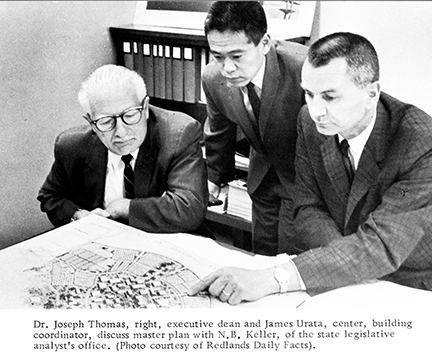
- State Senator Stanford Shaw introduced legislation for San Bernardino-Riverside State College.
1961
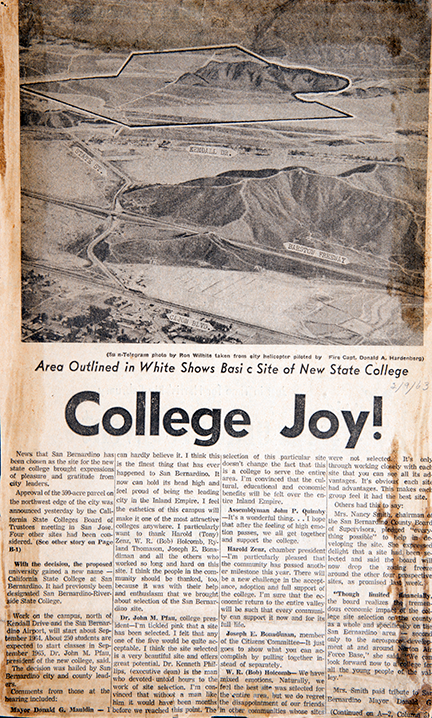
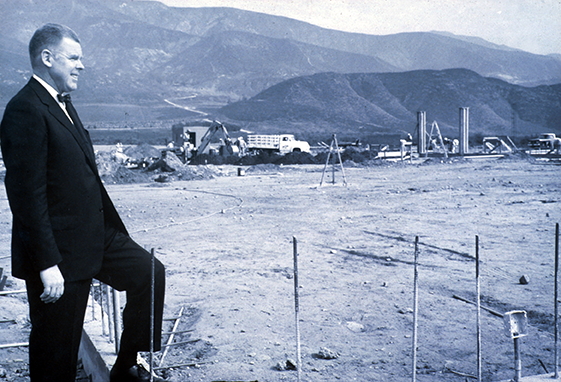
- Legislature appropriated funds to purchase college site.
1962

- John M. Pfau was appointed president.
1963

- College site chosen – 26 sites originally considered.
- The original name, San Bernardino-Riverside State College, was changed to California State College at San Bernardino (CSCSB).
- The initial purchase of 430 acres included 50 acres of vineyards. The area south of the playing fields was once a part of the vineyards owned by the Ellena Brothers of Rancho Cucamonga.
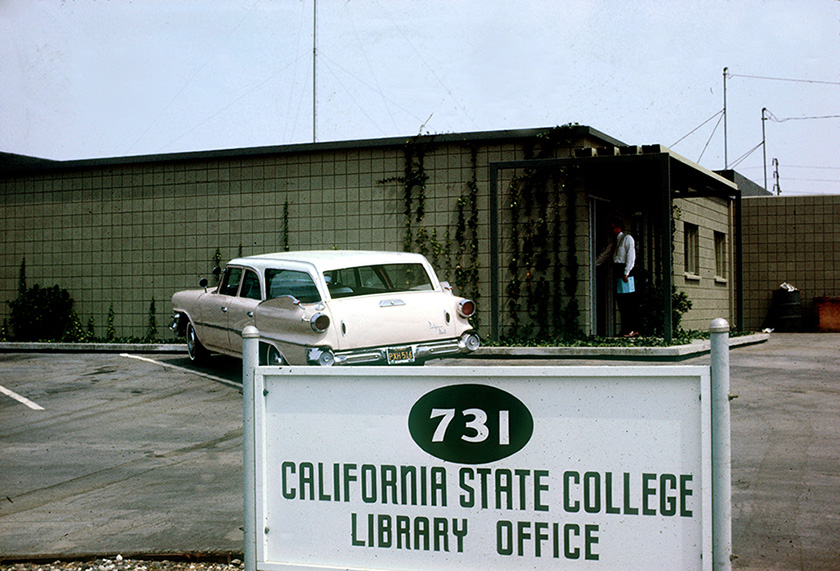
- Library collection was being assembled and stored in a warehouse at 731 South Lugo.
1964

- Groundbreaking was held for the three initial one-story buildings to be built on 13 acres at the western edge of campus. Initial buildings were: a 21,000 square-foot Administration building; a 19,500 square-foot Library-Classroom building, which had 52,000 volumes and 13 general classrooms; and a 15,300 square-foot Science and Activity-Cafeteria building. The complex also included a 285-car parking lot. Construction on the first three buildings and parking lot began at an estimated cost of $1,275,000.
1965
- The college officially opened with 293 students, 90 freshmen and the rest juniors. There were 93 faculty and staff.
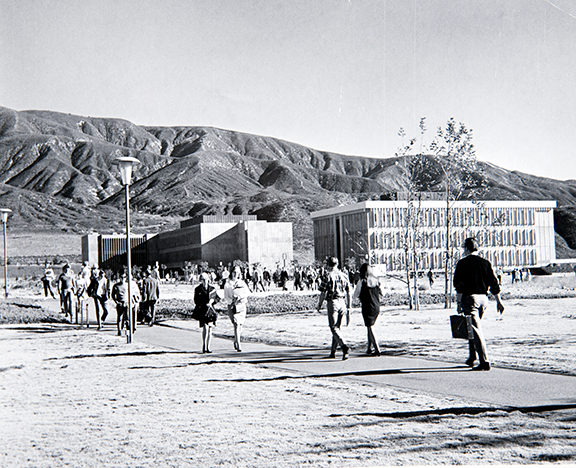
- Library opened.

- The Communique, the first newspaper for the college, was first published Nov. 9, 1965, and appeared as a mimeographed publication.
- State College Parkway, the four-lane thoroughfare linking the college to the Barstow Freeway, was officially opened.
1966
- The Communique became the official Associated Student Body (ASB) newspaper when student government was formed in January 1966.

- Students voted for the golden condor as the college’s mascot and the school colors of brown and gold in January 1966.
- Students voted a second time and chose the St. Bernard dog as the school mascot and the colors brown and light blue in April 1966

- Brown was chosen because it was the most prevalent natural color of the area – symbolic of the mountains and desert.
- Students voted to have a paw print as the student newspaper logo.
- The campus’ first yearbook, called T Tauri, was published.
- John M. Pfau was inaugurated as CSCSB’s founding president.
- International student advisors Don Woods and John Hatton issued the campus’ first visa documentation.
- First student pep rally – President John M. Pfau awarded letters to the college’s first “undefeated” football team and cheers were led by Theta Psi Omega cheerleaders and song girls. Following the bonfire and rally, everyone adjourned for an outdoor dance. The steps of the college library served as a bandstand.
- The Communique changed its name to The Pawprint.
1967
- The Physical Sciences and Biology buildings were built and opened.
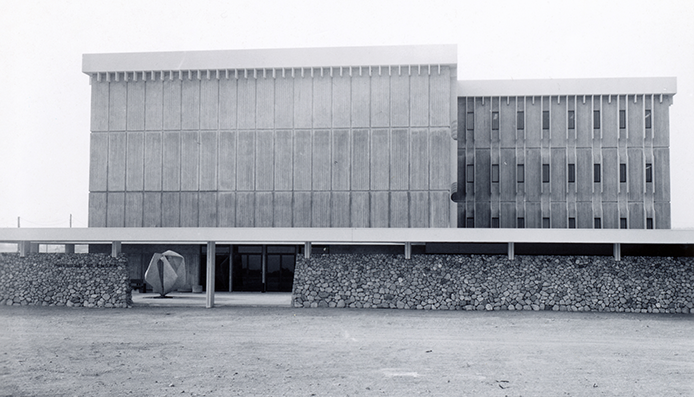
- English major Aletha Lorber was named Senior Woman of the Year.
- The San Bernardino Chamber of Commerce honored seven of CSCSB’s graduating seniors at a luncheon at the Holiday Inn. James K. Guthrie, publisher of the Sun-Telegram and a member of the College Advisory Board, spoke briefly and President Pfau responded. Students honored were: Geraldine Brame, Charlene De Branch, Aletha Lorber, Claudia Peterson, Carl Sundin, Clemens Tarter and Dorothy Wissler.
- 263 students attended the first summer session.
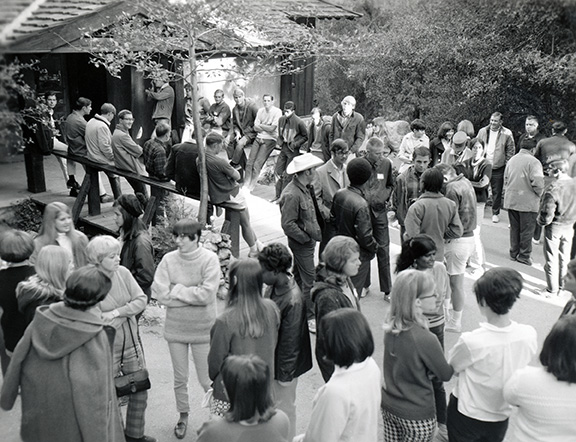
- The first graduating class was composed of 59 members, five graduating with honors. Honors were announced by Dean Scherba for Geraldine Ruth Brame, Charlene Kaye DeBranch, Aletha Lorber, Dorothy Wissler and Claudia Peterson – all married women. Chancellor Dumke delivered the Commencement address. The President’s Reception was held after the ceremony.
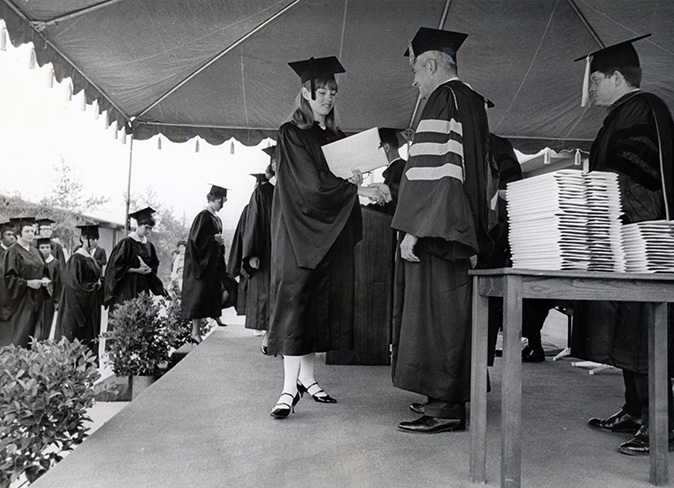

- CSCSB offered 14 majors to the 1,002 students who enrolled. Enrollment had increased 67% in one year.
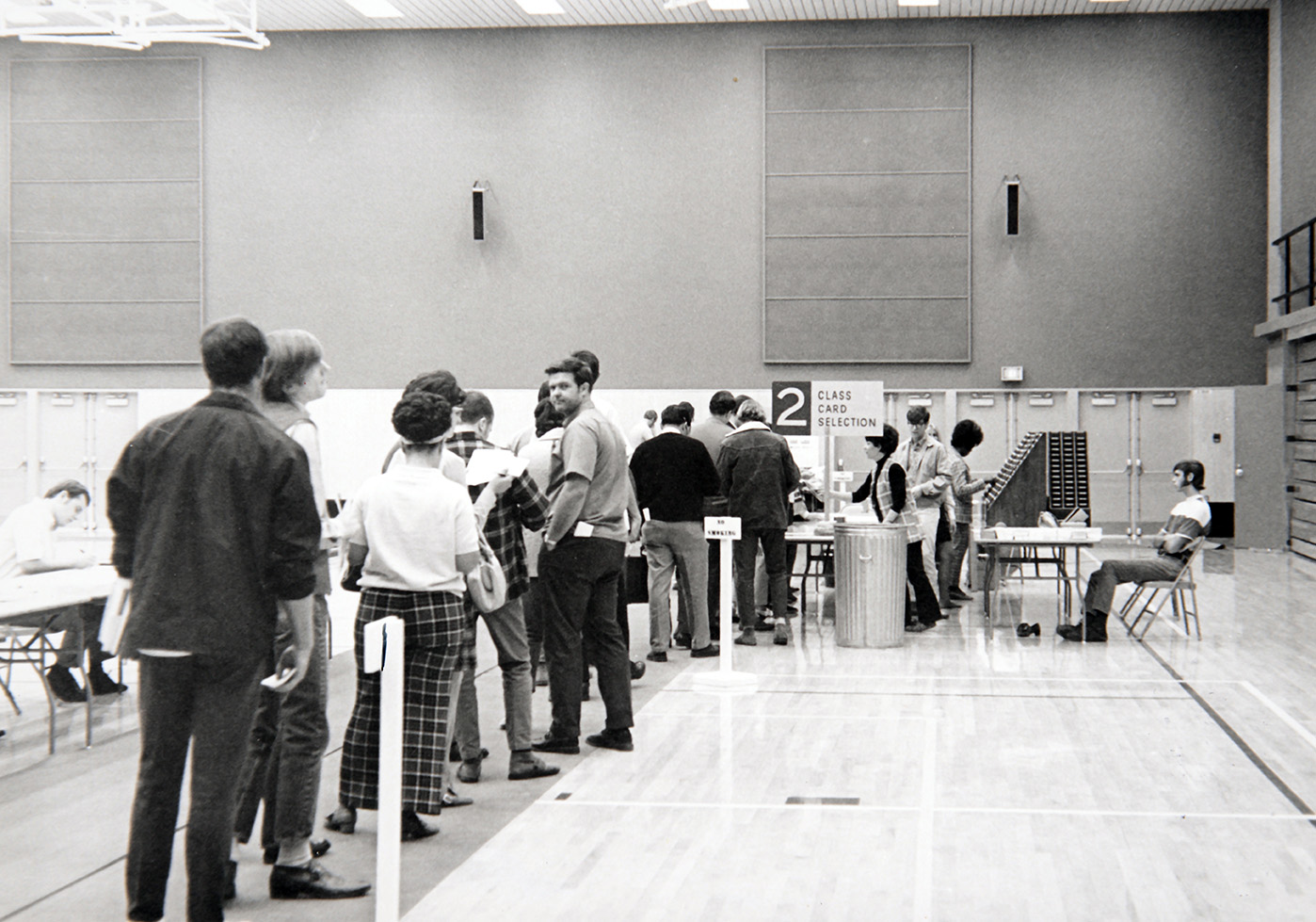
1968
- First Sunday guided tours of the campus were started. The tours were conducted by one of four students specially trained and outfitted with blazers for this purpose.
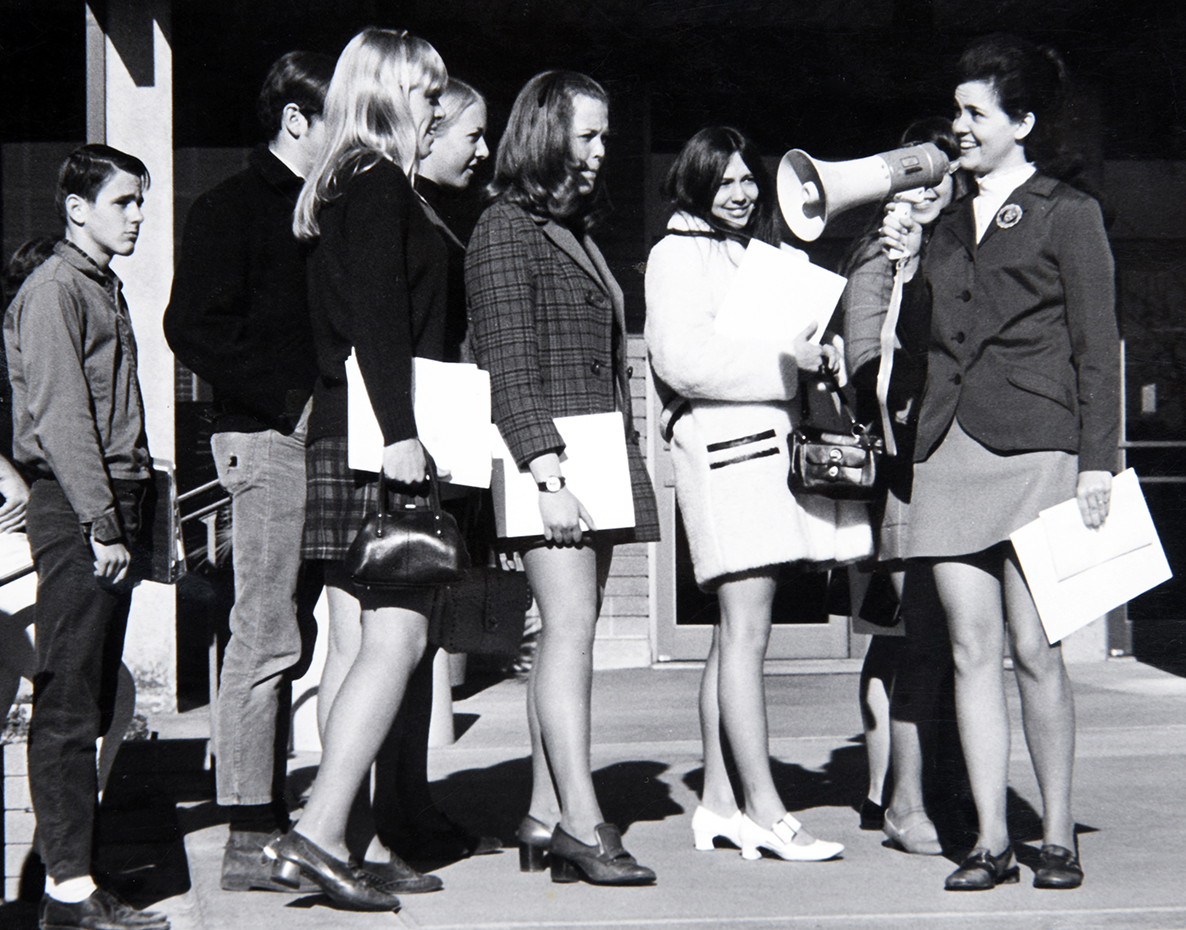
- Alumni Association published the first issues of its newsletter Panorama. Alumni held its first meeting Oct. 25, 1968.
- Heating and Air Conditioning operations opened, providing utility services for all campus buildings through an underground utility tunnel system.
- Physical Education building was completed at a cost of $1.2 million. Its 36,000 square-feet included a 1,450-seat gymnasium; 1 regulation and 2 practice basketball courts, activity room; classrooms, offices and a locker room; and a 75-feet x 45-feet pool with depths from 4 to 13 feet, and 2 one-meter and 1 three-meter diving boards.
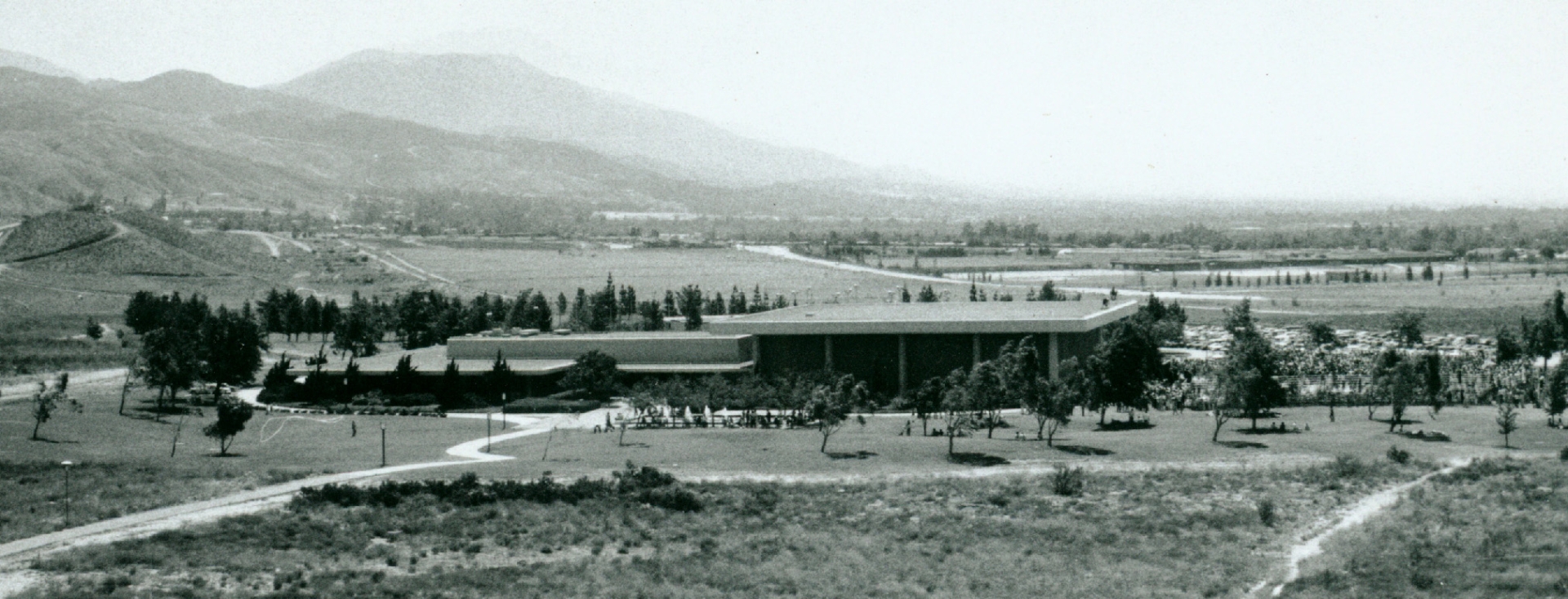
- Groundbreaking took place for a new Library-Classroom building.
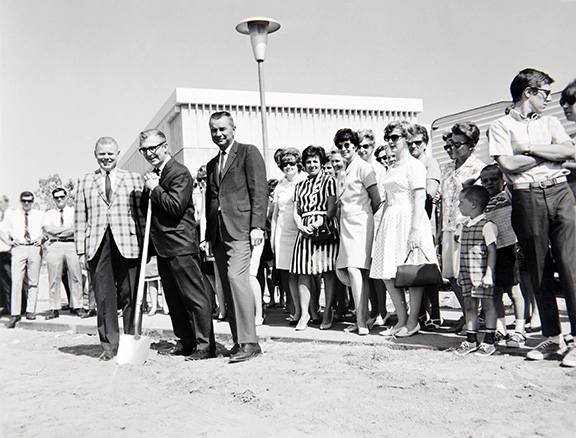
- CSCSB started its fourth academic year with its third name. The first name, San Bernardino-Riverside State College, gave way to California State College at San Bernardino when the college opened in 1965. The “at” gave way to a comma to make the names of the 19 Cal State colleges as consistent in style as possible: California State College, San Bernardino.
1969
- The 10,830 square-foot Physical Plant building and 29,000 square-foot shops and yard were completed in February 1969.
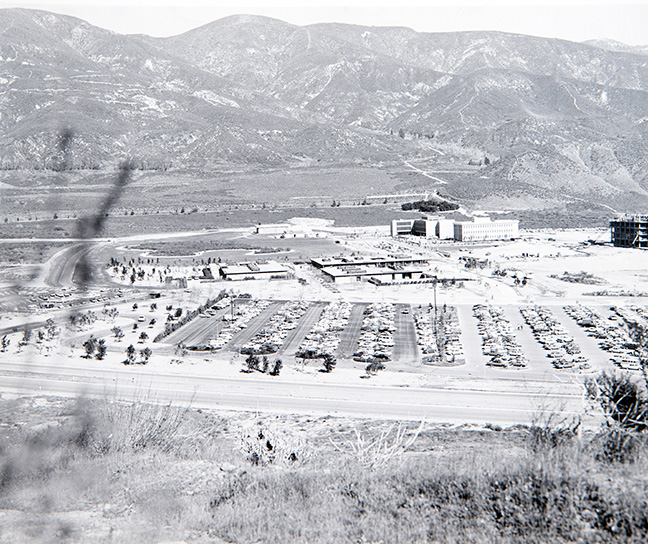
- The college’s third annual Commencement was the first to be held indoors, beginning at 8 p.m. in the CSCSB gym. One hundred and twenty-two degree candidates, out of 185 eligible to march, participated in the ceremony. “There Once Was a College at Camelot,” the Commencement address, was given by Louis H. Heilbron, former chairman of the California State Colleges Board of Trustees. The faculty marshals were Ronald Barnes, James Crum and Russell DeRemer.
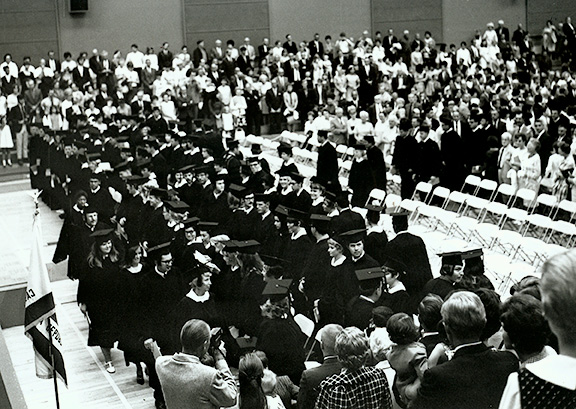
- The campus hosted its first Homecoming: a barbecue cook-off for CSCSB alumni.
1970
- The college’s authorized enrollment was 2,240 students. Although no graduate degrees would be awarded yet, 250 students were enrolled in the fifth-year teaching credential program or in scattered courses, which carried graduate and upper-division credit.

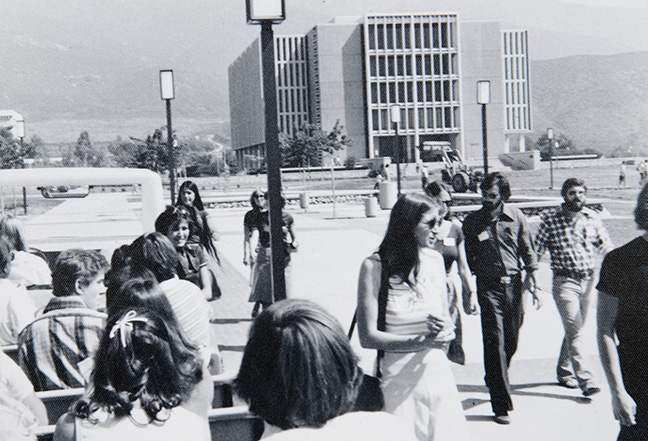
- The six-week program, Operation Second Chance, the first of its kind in San Bernardino, was constructed to give minority youth an opportunity to study and work in an intensive, tutored summer session.
- Ethnic studies options within the fields of history and sociology were introduced, providing students the opportunity of concentrating in either Mexican American or Black studies.
- Leta M. Adler was named a professor of sociology, making her the first woman full professor at CSCSB.

1971
- With construction completed on the five-story Library-Classroom building, the library collection was moved to the campus’ newest and largest structure.
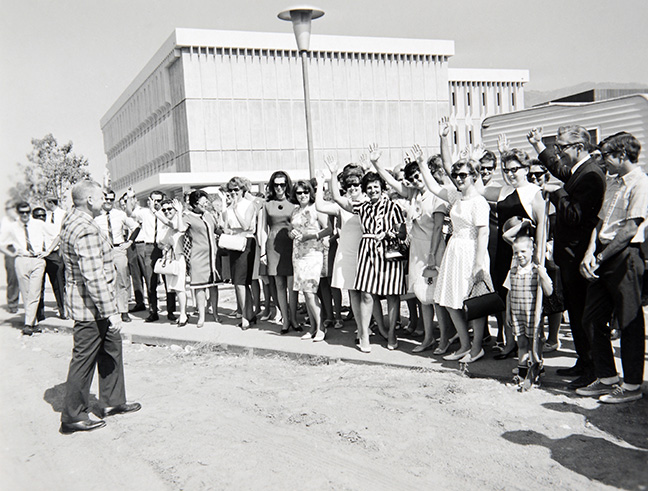
1972
- The college became a residential campus with the opening of dormitories in Serrano Village.

- The institution initiated its first graduate program, an M.A. in education.
- The Commons building opened, which served as general dining for the campus. Built at a cost of $1.3 million, the two-level structure seated more than 600.
1973
- The campus hosted the Black Cultural Festival, which brought 500 local high school students and soul singer Billy Paul to campus.
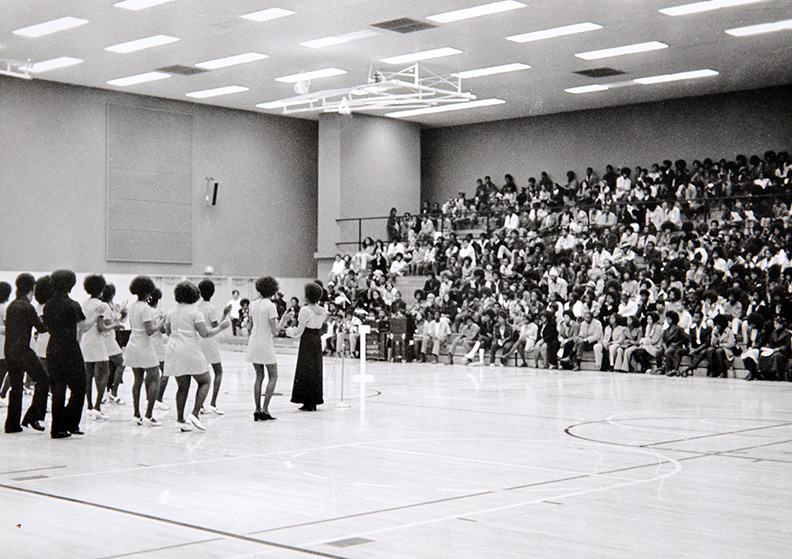
- The campus awarded its first master’s degree, which was in elementary education.

1974
- Federally funded educational opportunity programs, including Upward Bound, were launched on campus to enhance the college-going rate of students from disadvantaged backgrounds.
- CSCSB students participated for the first time in the annual Model United Nations program in New York City, representing the country of Kuwait.
1975
- The college celebrated its 10th anniversary and groundbreaking for the Creative Arts building.

- Receiving, Mail and Campus Stores building was completed, covering an area of 3,200 square feet.
- Forty-three of the original 93 faculty and staff were still on campus.
1976
- Construction began on the $860,576 Student Union. All costs were paid from student fees and the sale of revenue bonds, which were repaid from future student union fees.
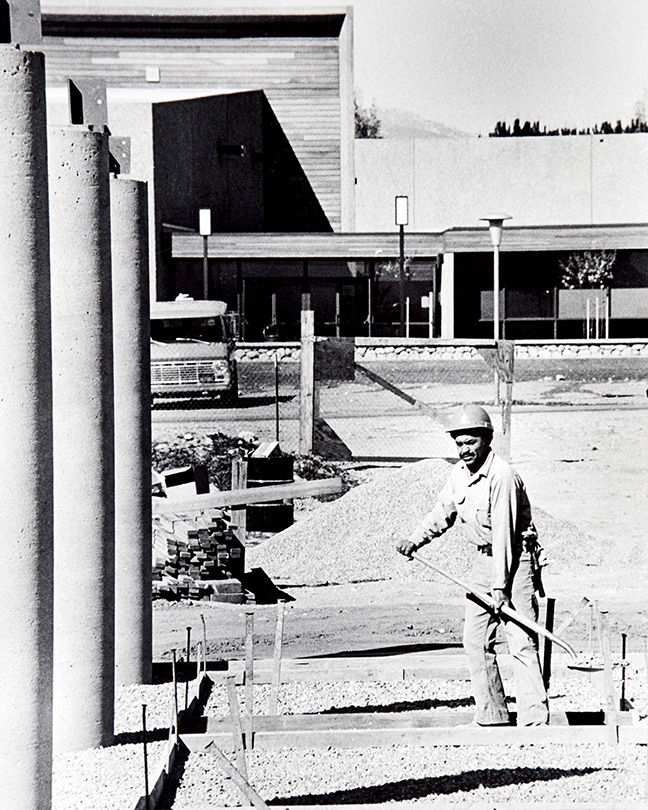
1977
- The library acquired its 250,000th volume.
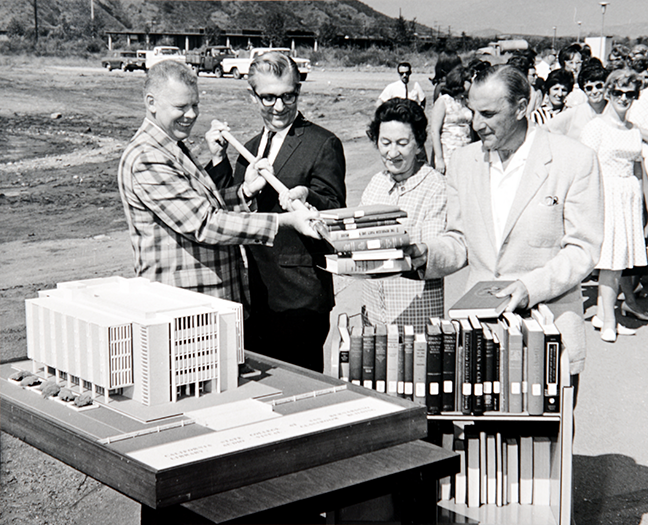
- The College Bookstore opened.


1978
- The 15,000 square-foot Student Union Building officially opened. The union housed a multi-purpose room for dances, lectures, films, etc.; student government offices and school newspaper office; a “noisy room,” which had two billiard tables, pinball machine and ping pong tables; a vending machine room and snack bar; a lounge with fireplace and outdoor patio.

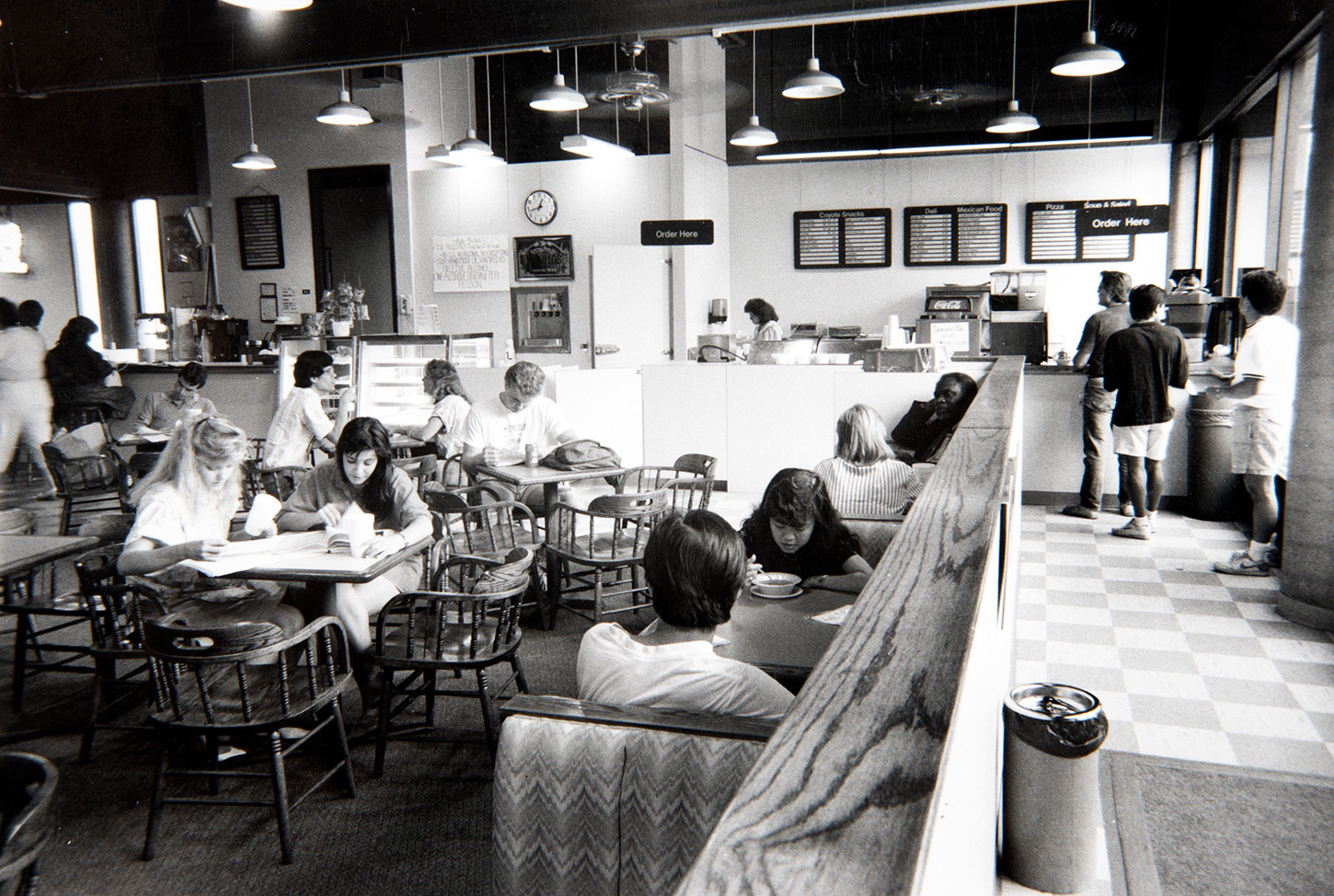
- Students voted to change the name of their government organization from Associated Student Body (ASB) to the Associated Students, Incorporated (ASI).
1979
- The Fine Arts Building was remodeled during the 1978-79 academic year to include ceramics, sculpture, woodworking, furniture design and weaving studios.

- The Student Health Center opened.
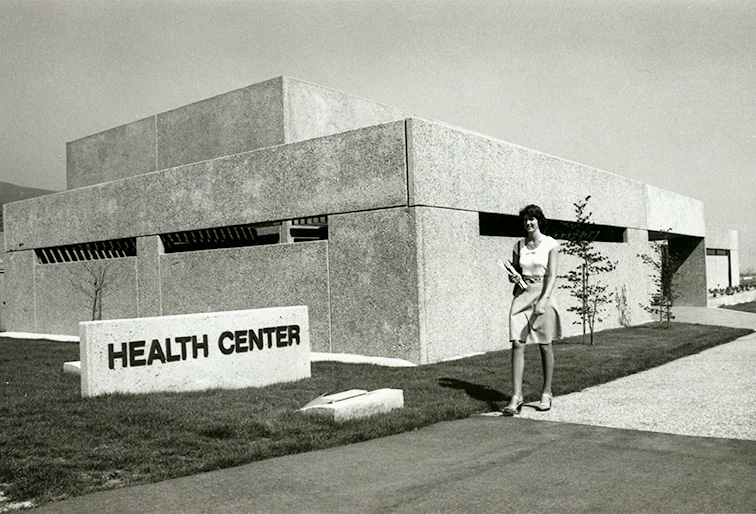
1980
CSCSB celebrated its 15th anniversary by hosting its first Open House in a major effort to draw community attention to the campus.

- The Children’s Center opened on campus with the benefit of federal community development grants awarded to the city and county of San Bernardino.
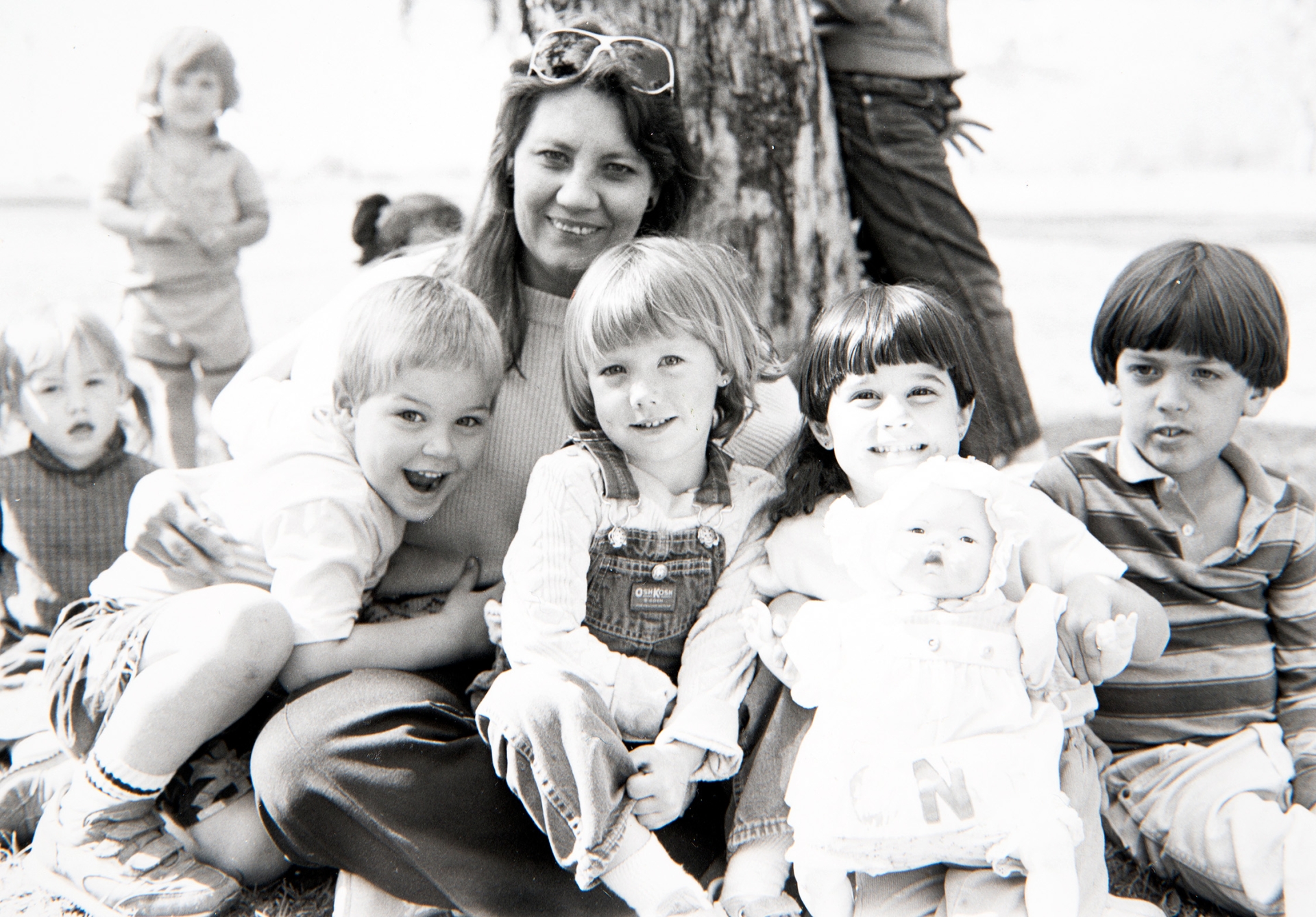
- Panorama Fire destroyed the Shipping and Receiving Warehouse on campus and severely damaged the cooling towers on the Heating and Air Conditioning building.
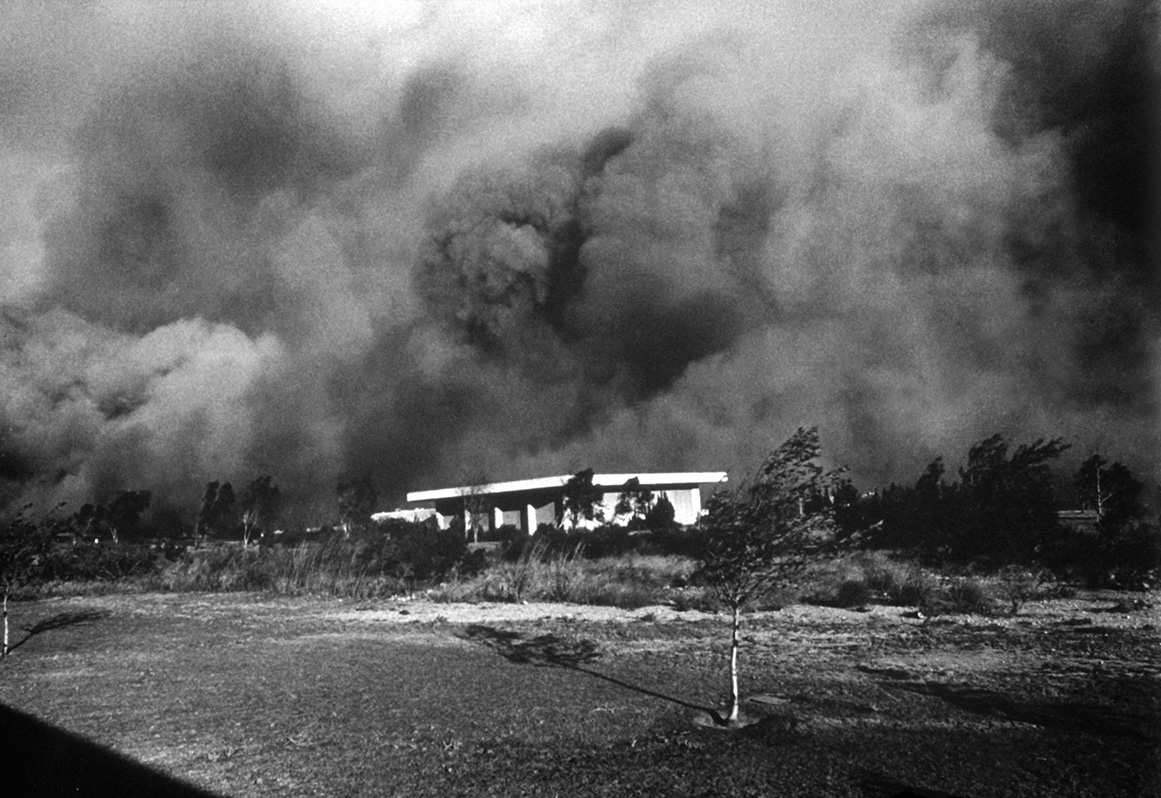
1981
The movie “Buddy, Buddy” was filmed on campus featuring actors Jack Lemmon and Walter Matthau.
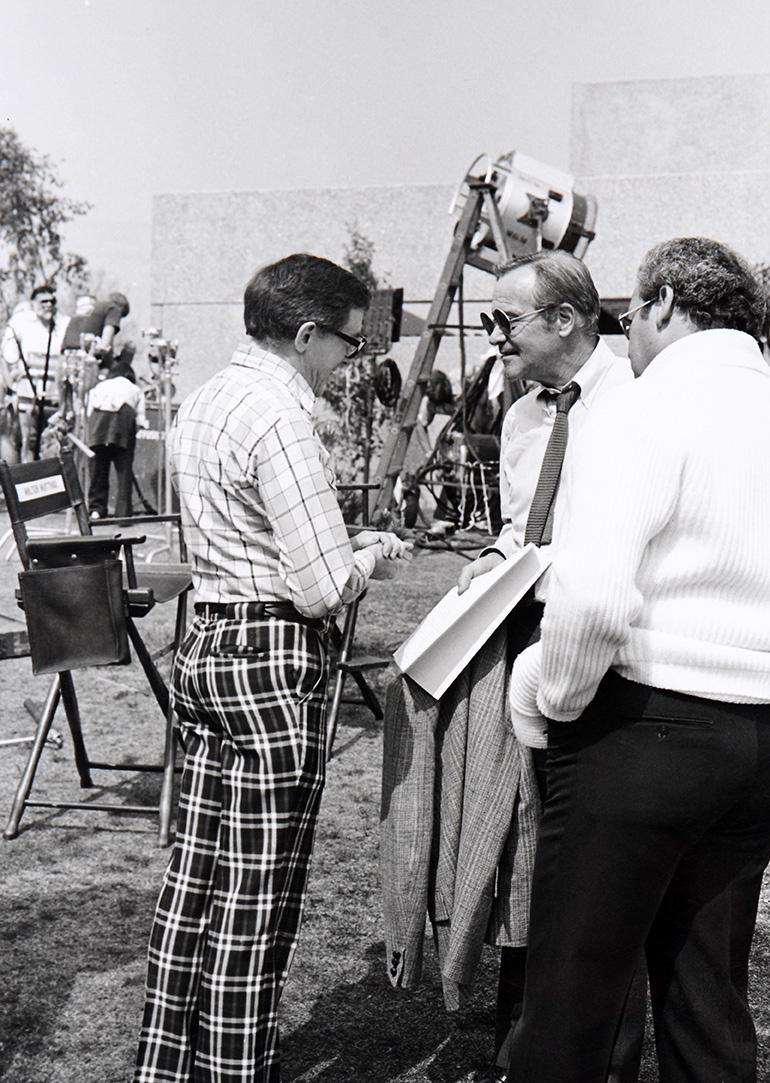
- Robert O’Brien in sociology became the first to be honored with the campus’ new Outstanding Professor Award.
1982
- Anthony H. Evans was appointed president of California State College, San Bernardino as it enrolled 5,600 students in 36 undergraduate majors and eight graduate degree programs.
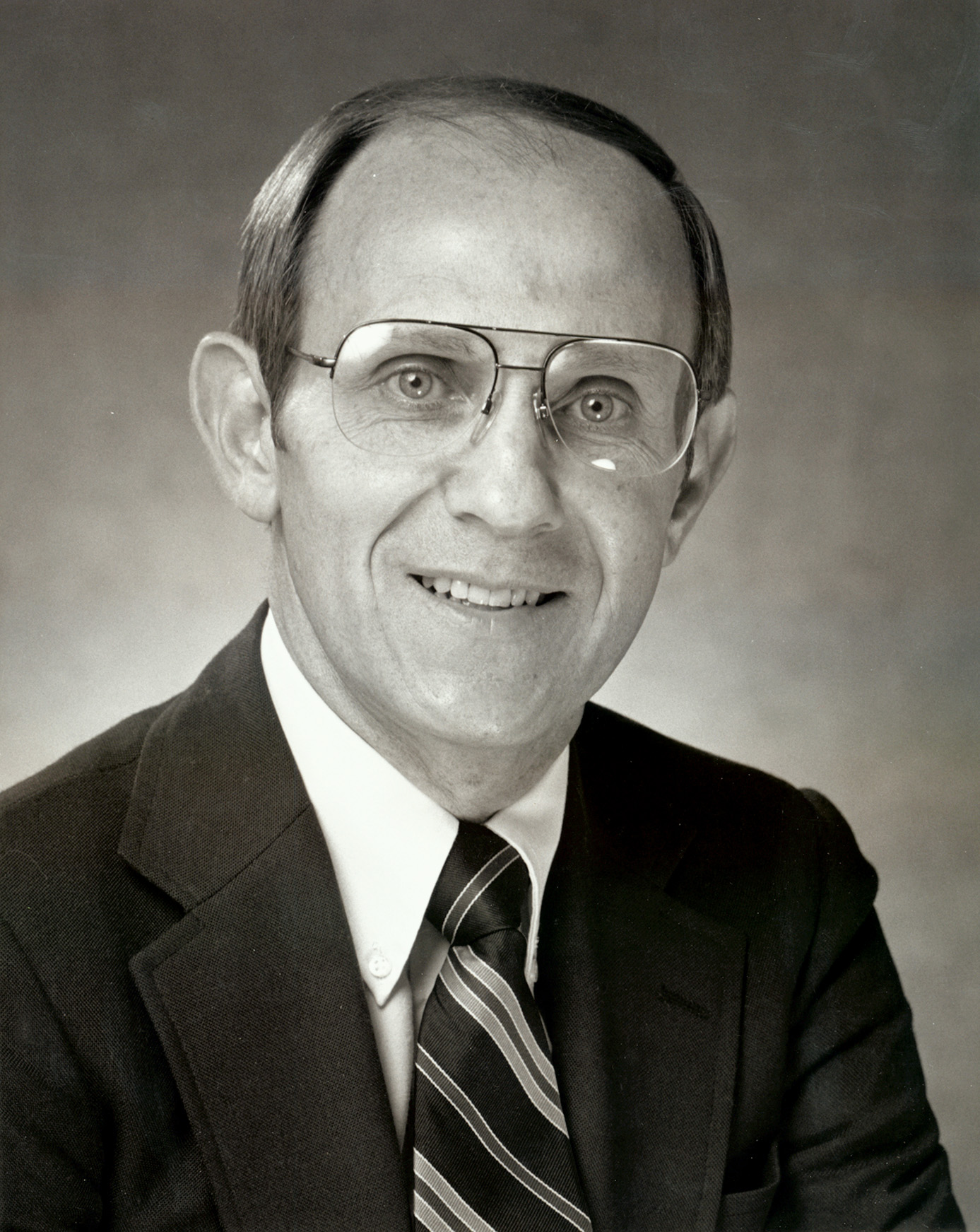
- Library holdings numbered 340,000 volumes and the campus housed 23 air-conditioned buildings
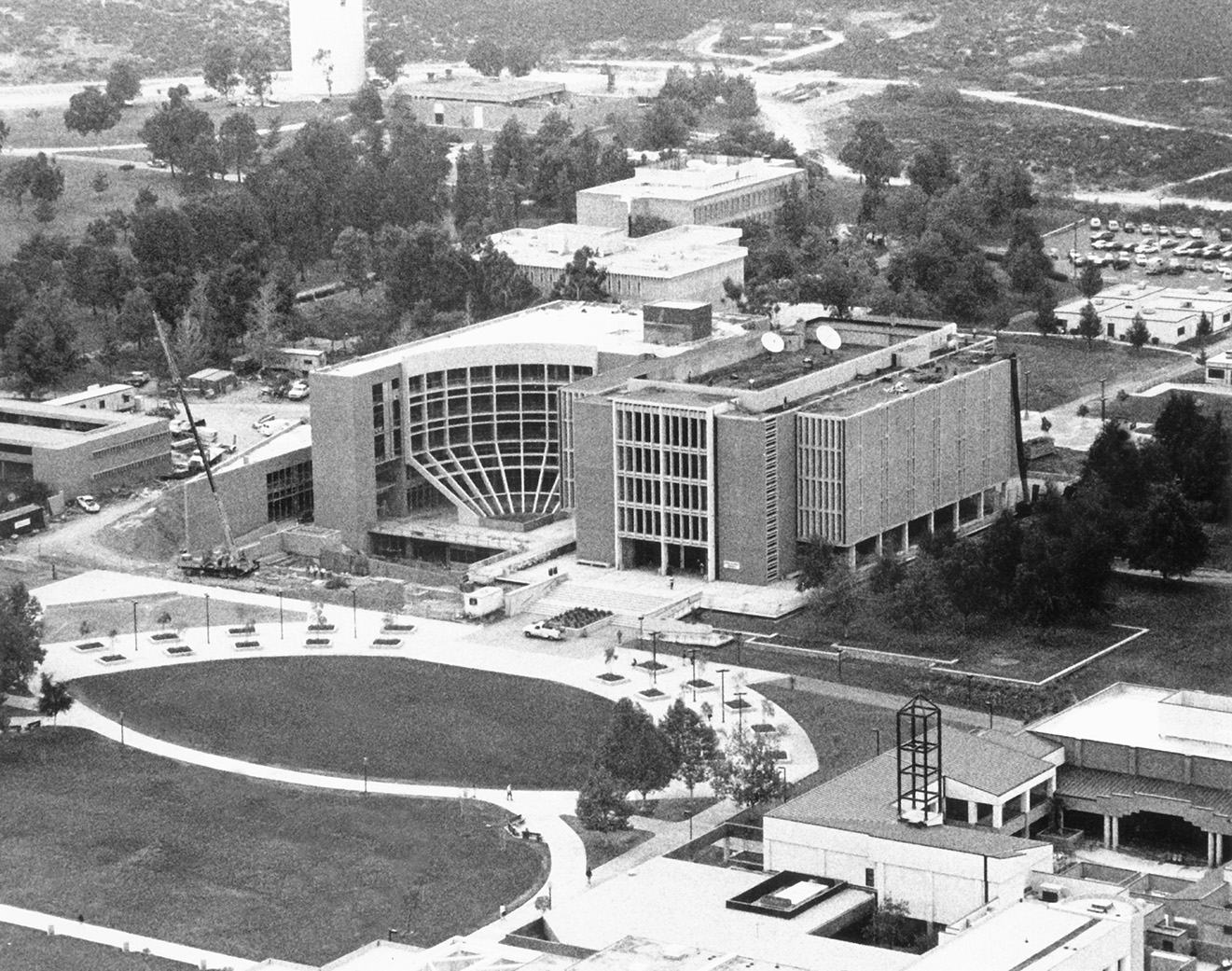
- Board of Trustees named John M. Pfau Library in honor of the retiring founding president.
1983
- President Evans was inaugurated as the second president of the college.

- President Evans appointed a 12-member taskforce to discuss the issue of bringing intercollegiate athletics to CSCSB as a means of enhancing student development.
- Students voted 946-478 to double their instructionally related activities fee to $20 to fund an intercollegiate athletics program at CSCSB.
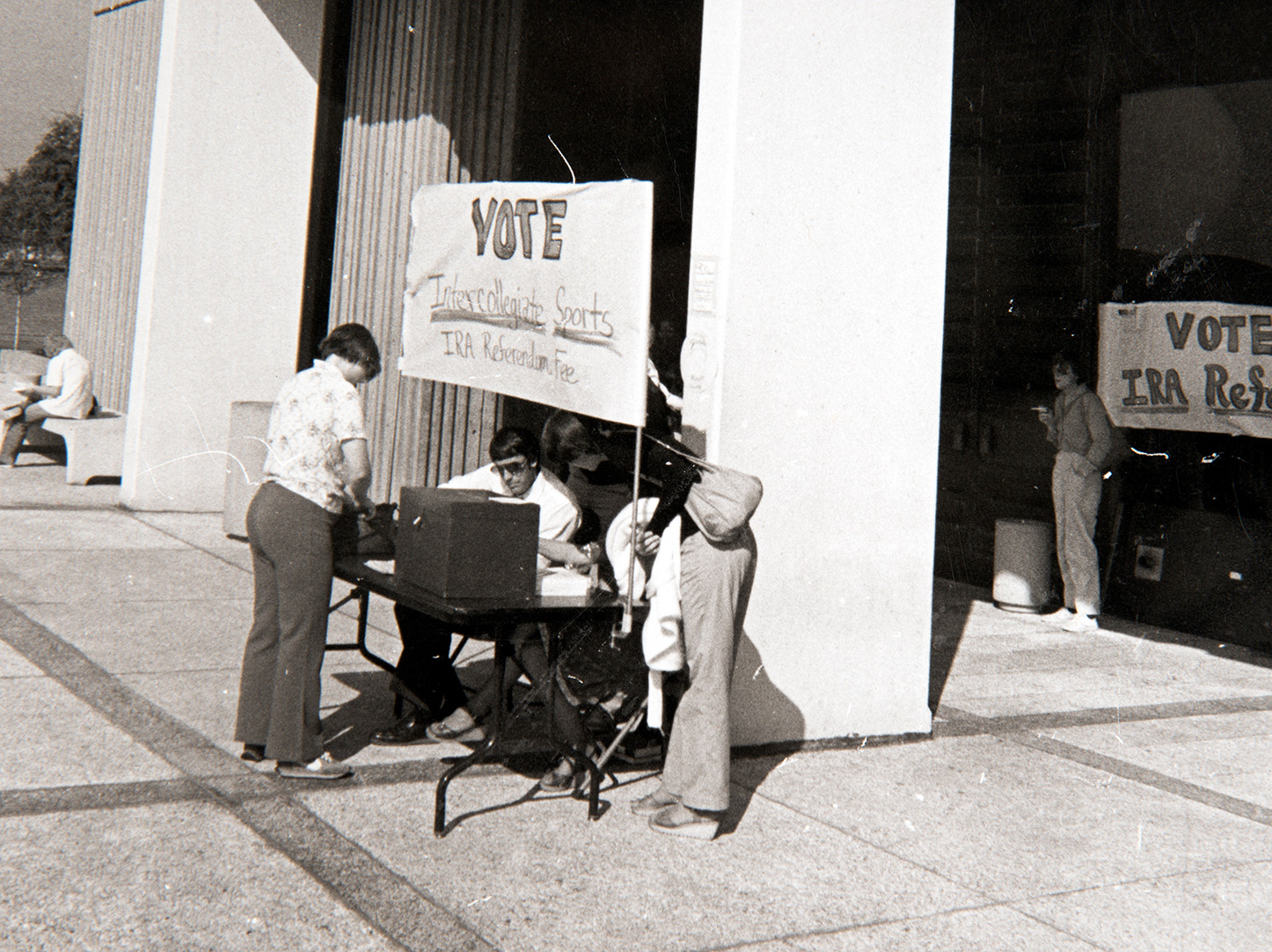
1984
- The coyote became the official mascot for CSCSB following an extensive survey by an ad hoc study committee.

- The campus newspaper, The Pawprint, changed its name to The Cal State Chronicle.

- California State College, San Bernardino officially became a university when the California Postsecondary Commission ratified the CSU Board of Trustees’ earlier action to certify the institution had met necessary requirements to be a university in the CSU system. The next day the campus held ceremonies to change the sign at the main entrance to the university.

- The National Collegiate Athletic Association (NCAA) accepted CSUSB as a member of Division III and authorized the school to compete in eight intercollegiate sports.

- First NCAA-sponsored athletic contest involving CSUSB was a 4-3 men’s soccer victory over the University of Redlands.

- The campus received a 10-year accreditation by the Western Association of Schools and Colleges (WASC).
1985
- Ruben Mendoza and Tim Stretch of the men’s tennis team qualified for the NCAA Division III National Championship tournament and made it to the quarterfinals in doubles.

- Summer session had a record enrollment of 1,425 students enrolling in five sessions or attending special workshops in August.
- Institute for Applied Research was founded in the School of Business and Public Administration.
- Enrollment of 6,519, an 11.5% gain over fall 1984, was the greatest increase in one quarter in the history of the university.

- The Advising Center was established.

- Five mobile units, located between the Student Services Building and the Child Care Center, opened to provide temporary faculty offices.
- Library received a 60-day free trial of Info trace, an automated reference database system, which had access to information from 1,000 periodicals (from 1982-1985) and two newspapers (past 60 days).

- Volleyball team hosted its first tournament, which was co-sponsored by the Soroptimist Club of San Bernardino. Participants included CSUSB, Whittier, Claremont and Master Colleges.

- $135,000 worth of equipment was purchased for Instructional Fixed Television Source (ITFS), allowing the university faculty to teach – via television – to students in the Coachella Valley.
- Special Convocation marked the 20th anniversary of the campus.
- Faculty Computer Users Committee was established to determine the computer needs of faculty and to make recommendations for a five-year plan.

1986
- The Coachella Valley Center opened when CSUSB established a satellite campus at the College of the Desert. The university offered junior, senior and graduate-level classes in 15 different programs.
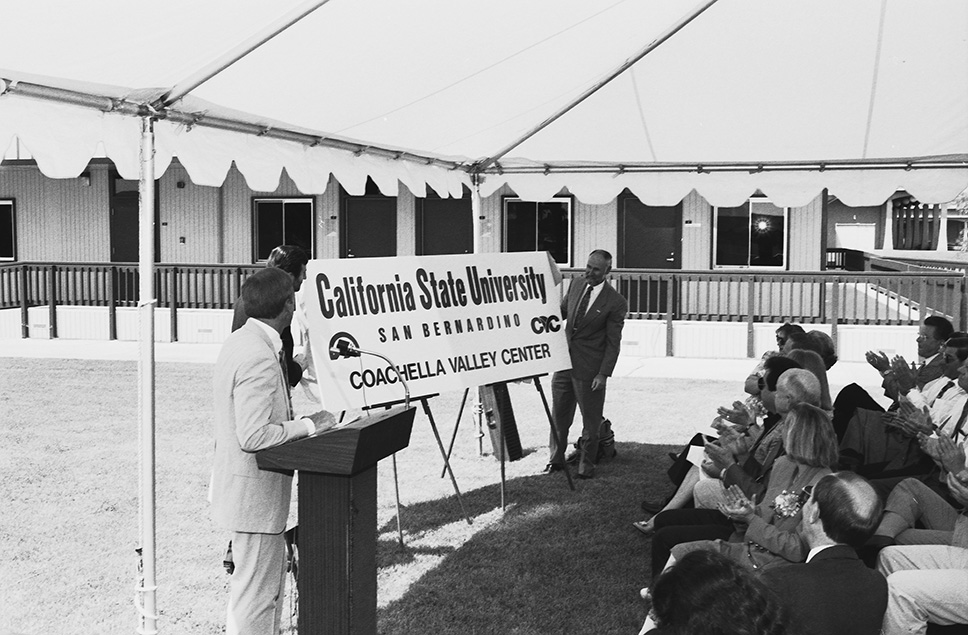
- First Homecoming Weekend was celebrated around Coyote basketball.
- 3,007 students signed up for classes in the university’s first computer-assisted registration (CAR).
- Six concerts comprised the university’s first Summer Entertainment Series.

- Spring enrollment was 6,338 students, a 13.8% increase over spring 1985.
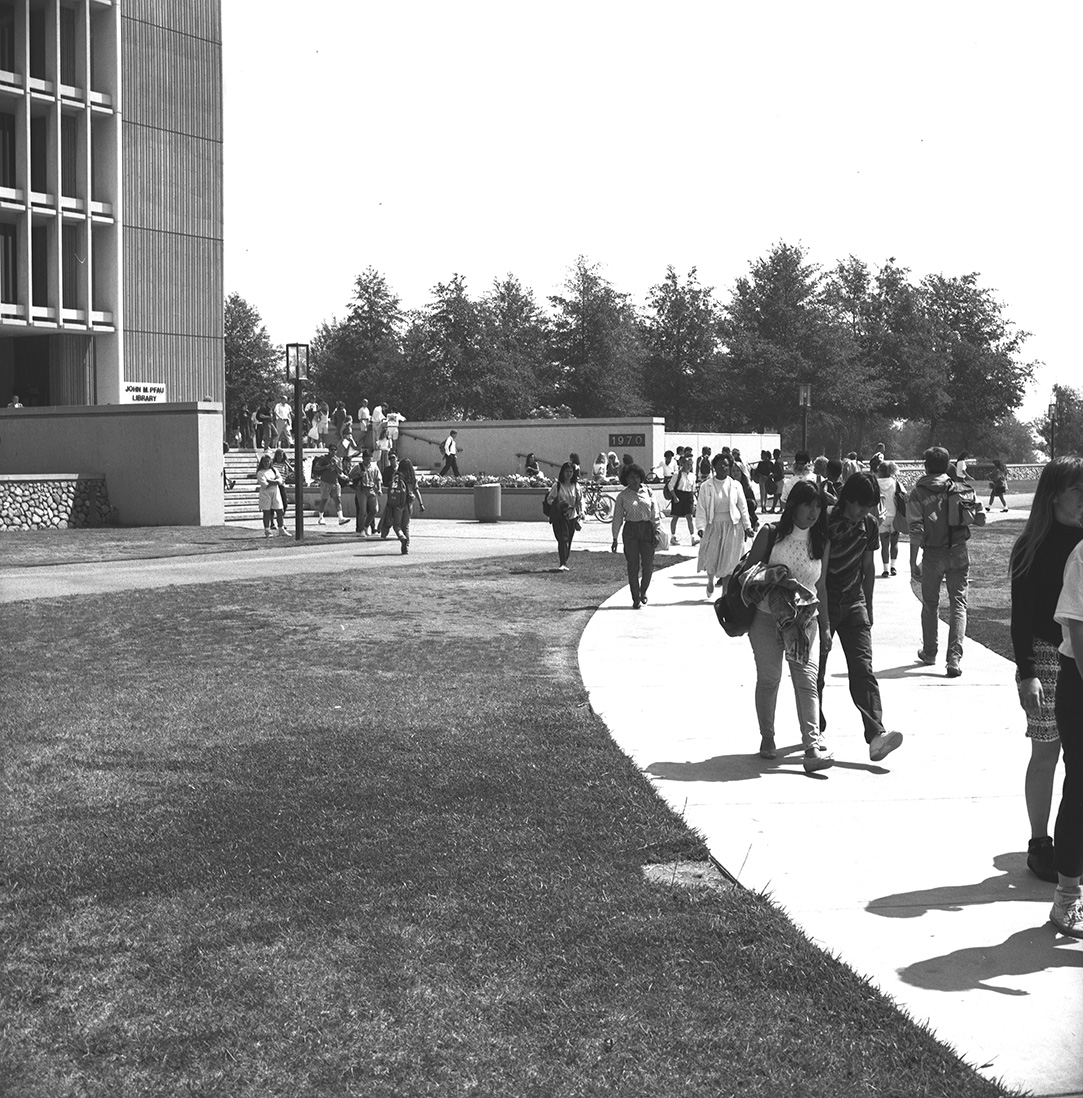
- 7,444 students enrolled at CSUSB in fall, a 14% increase above the official student population for fall 1985.
- The 20th Commencement graduated 1,170 students.
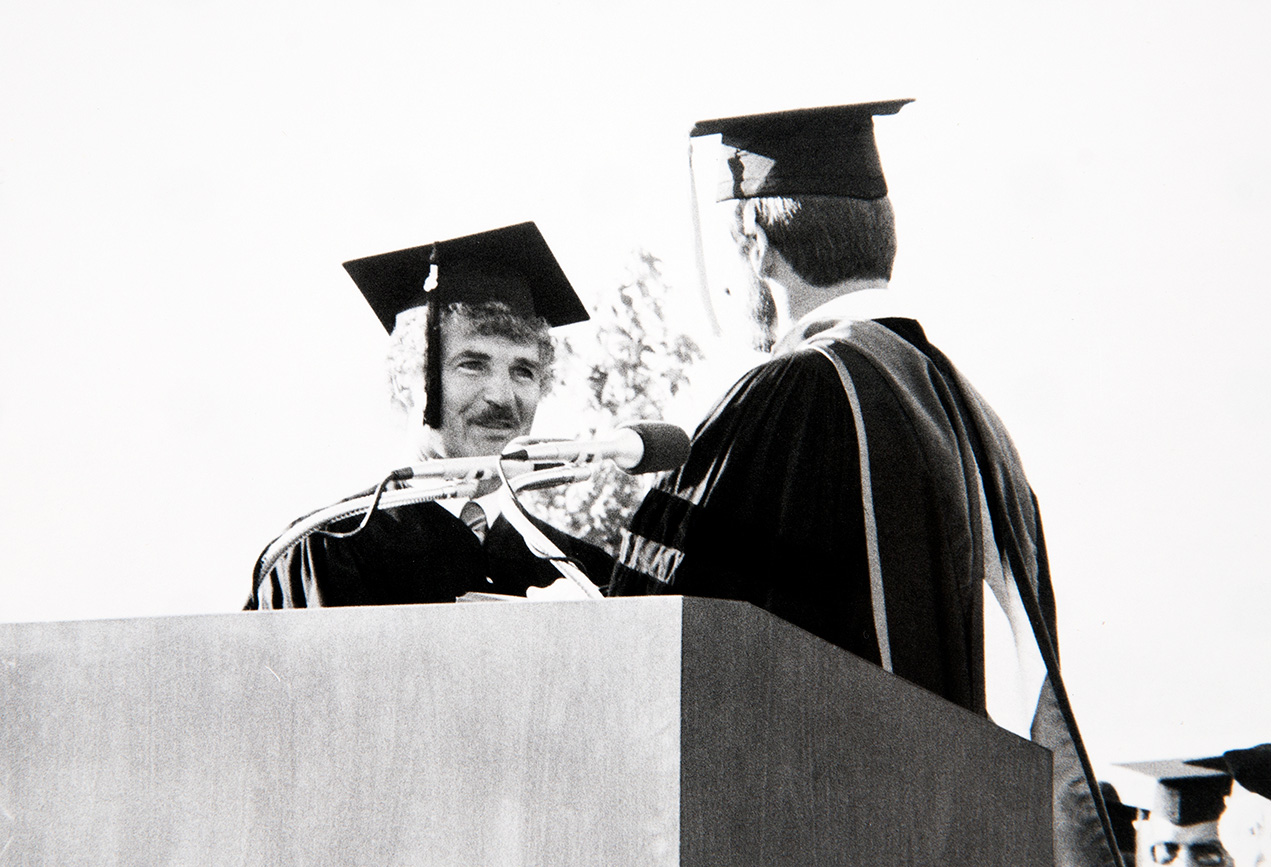
- The 50th degree program, a B.S. in foods and nutrition, was offered.
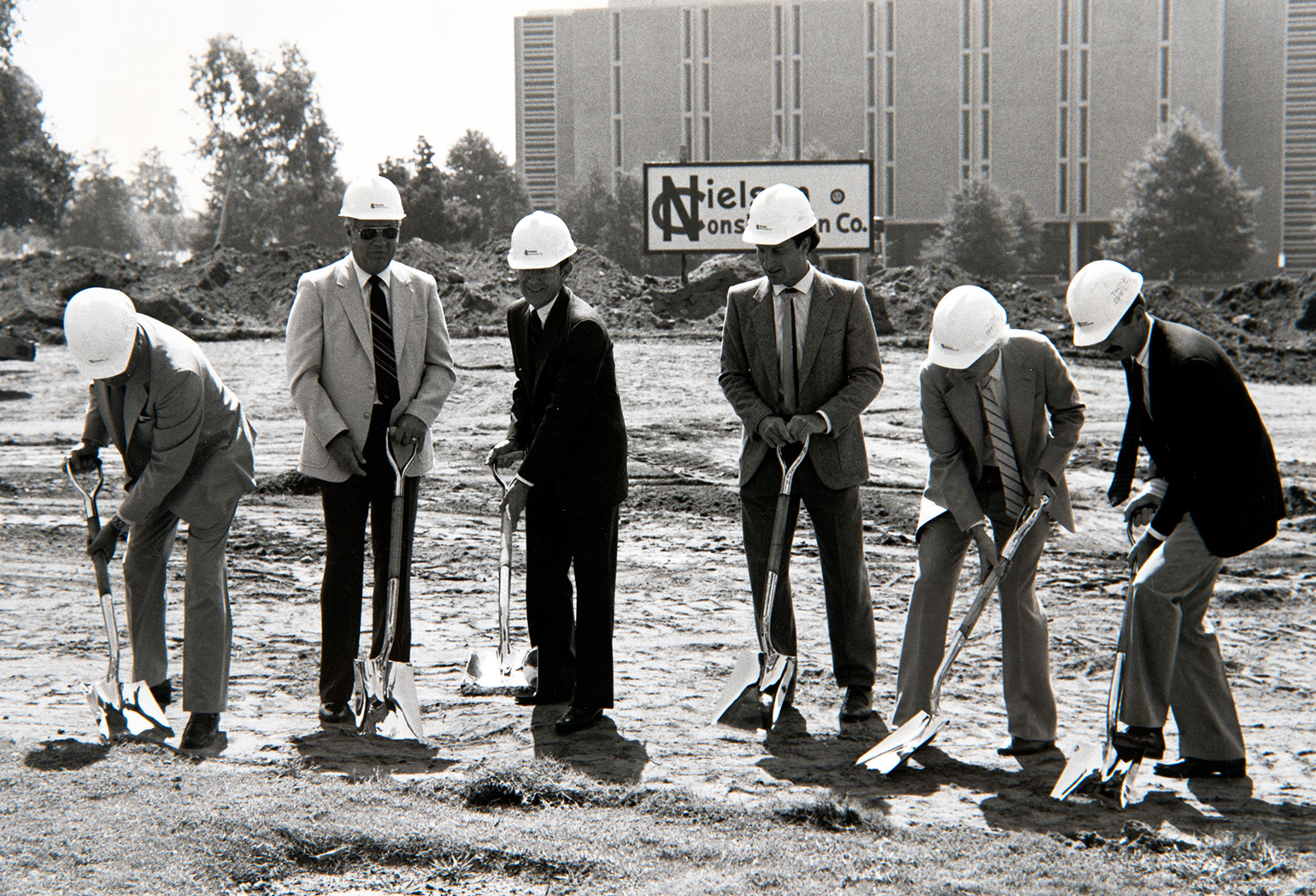
- Construction began on the $2.3 million, two-story Faculty Office Building, designed to accommodate 81 faculty plus administrative offices for the Schools of Education, and Social and Behavioral Sciences.
- The new campus radio station, KSSB, began broadcasting.
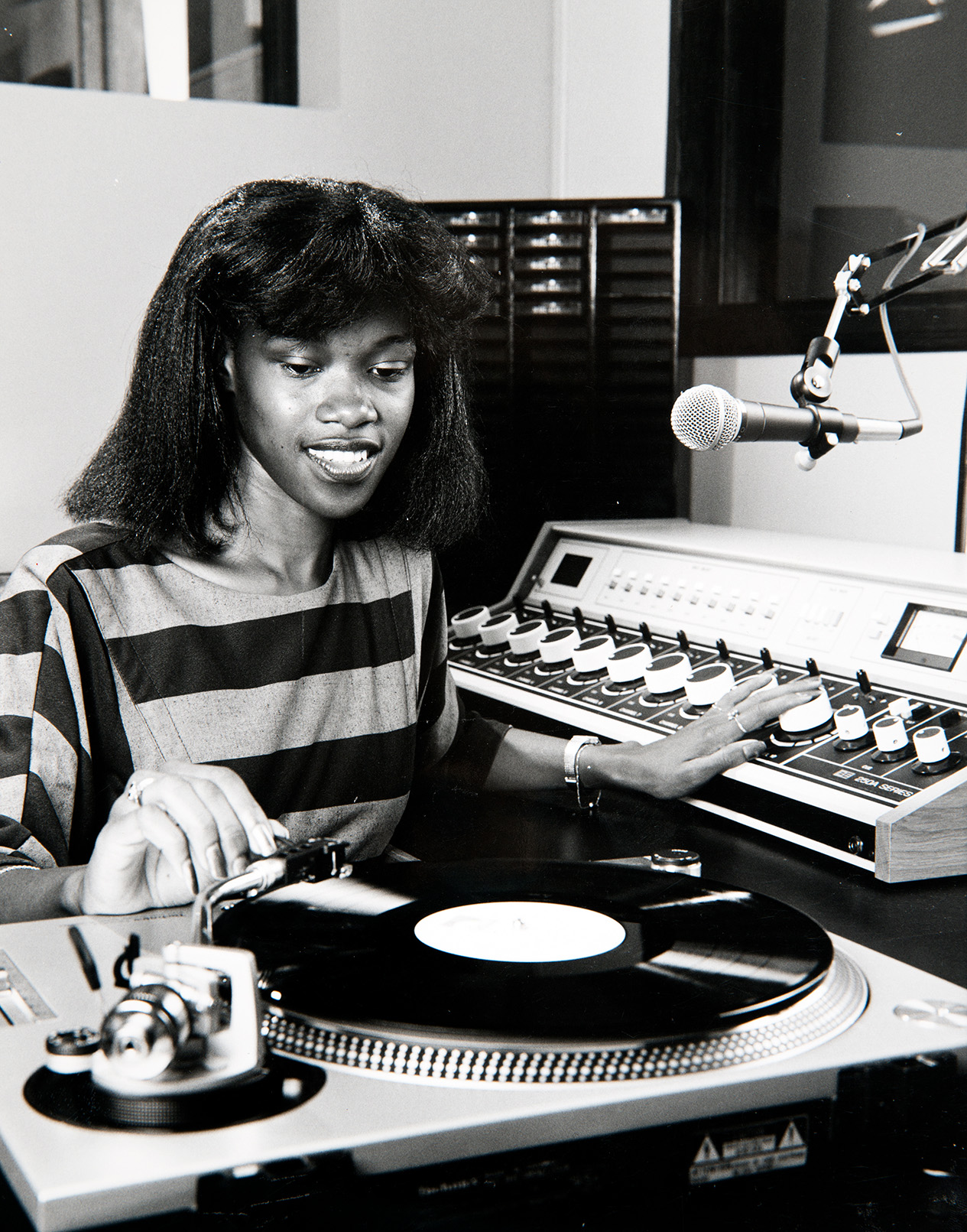
1987
- Census date recorded an enrollment of 8,376 students, an increase of 12.5% over fall 1986. The campus became the leader in the CSU for enrollment growth this year.

- Greek Life began on campus: 300 students enrolled in three sororities (Alpha Kappa Alpha, Alpha Phi, Alpha Delta Pi) and two fraternities (Delta Sigma Phi, Sigma Chi Omicron).
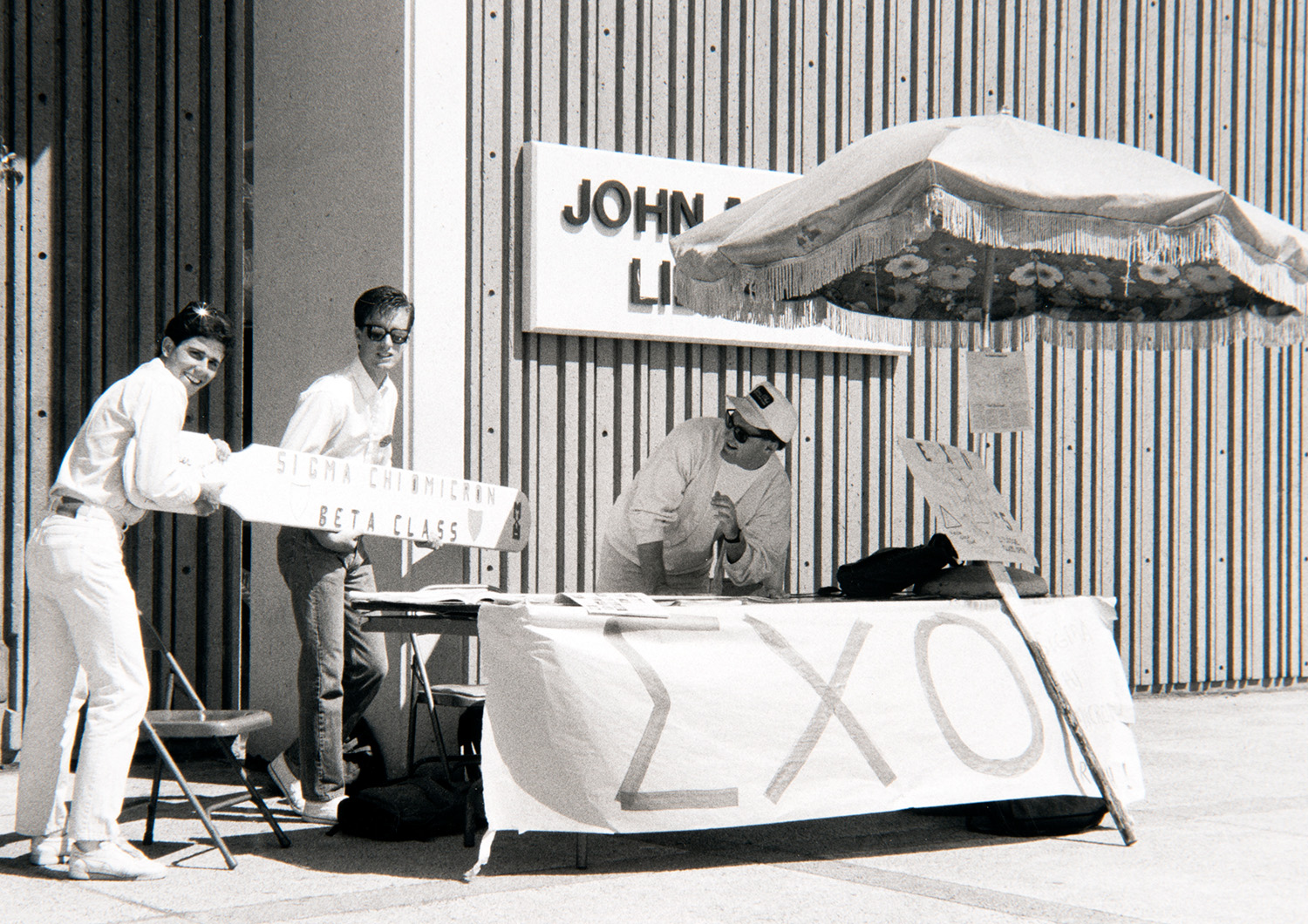
- Groundbreaking was held for a 3,863 square-foot addition to the Bookstore.
- 1,369 seniors and graduate students were part of the class of ’87.
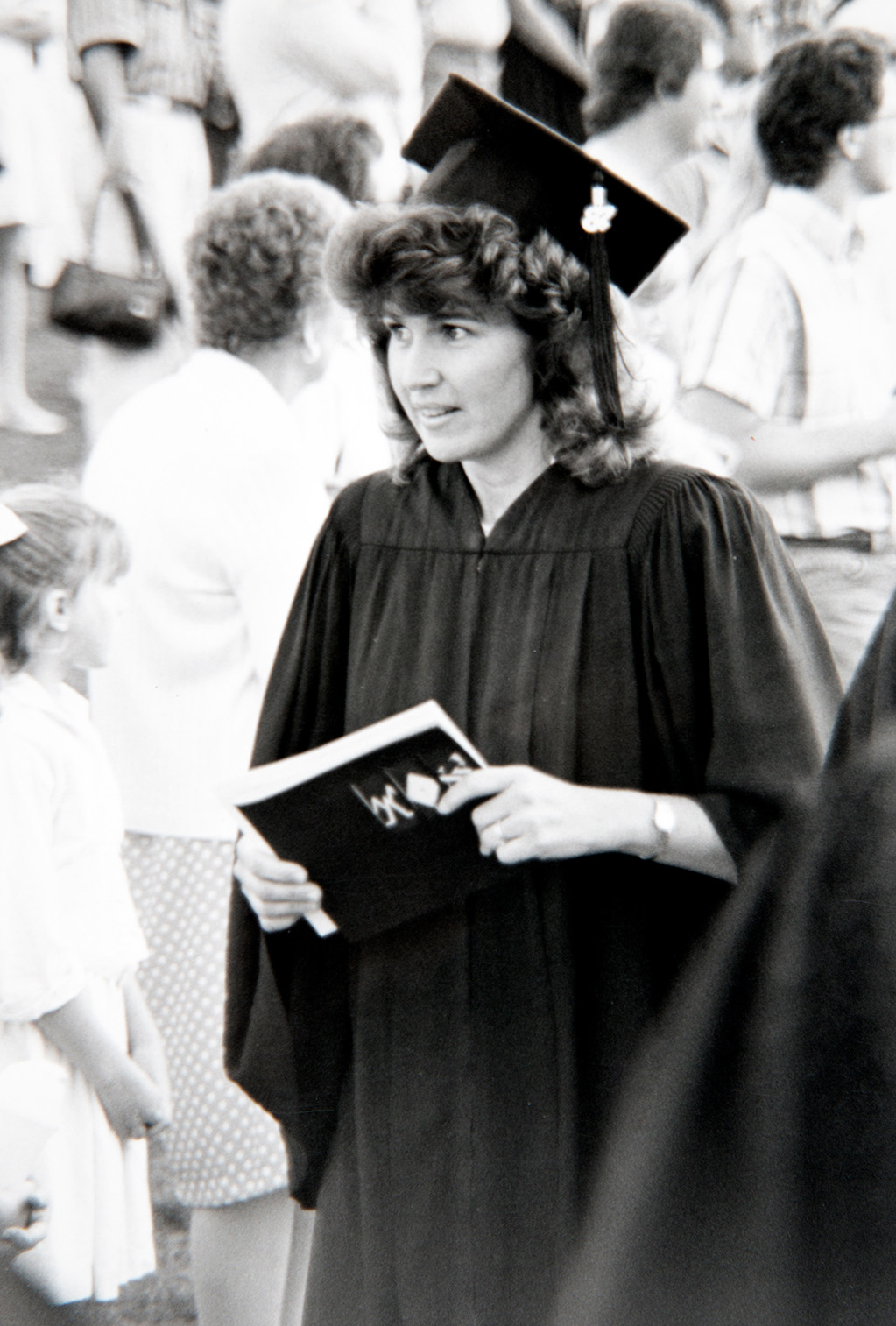
- Coachella Valley Center enrolled 403 students, representing an increase of 70% over the previous fall.
1988
- Men’s golf finished in third place at the NCAA Div. III national championship. Women’s volleyball advanced to the NCAA Div. III West regional title match.
- The university implemented its second joint Ph.D. program with Zagazig University in Egypt.
- A dedication ceremony was held for the Coachella Valley Center; 400 students were enrolled in 51 sections of classes, offered through an instructional television hook-up with the San Bernardino campus.
1988
- Men’s golf finished in third place at the NCAA Div. III national championship. Women’s volleyball advanced to the NCAA Div. III West regional title match.
- The university implemented its second joint Ph.D. program with Zagazig University in Egypt.
- A dedication ceremony was held for the Coachella Valley Center; 400 students were enrolled in 51 sections of classes, offered through an instructional television hook-up with the San Bernardino campus.
1989
- The university made a major change in its curriculum with a shift from 5 units course credits to 4 units course credits.
- Men’s basketball became the first CSUSB team to host an NCAA tournament playoff game, losing in the Div. III West Regional in the first round.
- The Honors Program was inaugurated to enhance diversity on campus.
- Library signed a contract with NOTIS Systems to be a beta test site for KEYNOTIS, an integrated online public access catalog.
1990
- Celebrating its 25th anniversary, the Library acquired its 500,000th volume.
- President Evans marshaled a taskforce on campus safety.
- The university announced its decision to move from Division III to Division II level NCAA competition, effective fall 1991, and affiliate with California Collegiate Athletic Association.
- Men’s basketball won NCAA Div. III West Regional and finished fourth in the NCAA championship tournament.
- The long-anticipated construction of a $20 million classroom/student service/faculty office building, University Hall, commenced.
1991
- Student Val Limar starred in “Ethel,” a hit musical based on the life of the blues singer Ethel Waters.
- Men’s basketball repeated the Western Regional championship and finished sixth in the NCAA championship tournament.
- University Hall building opened.
- Coyote Athletics moved up to NCAA Division II and joined the CCAA with eight teams.
1992
- The Foundation Building and Jack H. Brown Hall were completed.
- Men’s soccer gave CSUSB its first championship and hosted the West Regionals.
- An electron microscope was acquired by the university through a federal award announced by Congressman George Brown.
- The American Association of State Colleges and Universities lauded CSUSB’s mentoring role with the Hillside-University Demonstration School as a model partnership and gave it the Christa McAuliffe Award.
- “A Warring Absence,” an original play written by theatre arts alumna Jody Duncan and professor emeritus Bill Slout, was performed at the Kennedy Center for the Performing Arts as part of a national theater award for the work.
- The Social Work graduate program received national accreditation.
- A ribbon-cutting ceremony at the University Art Gallery marked the official unveiling of 300 Egyptian antiquities from the Harer Family Trust Collection.
1993
- Jack H. Brown Hall opened and was named for a $1 million personal contribution by the CEO, president and chairman of the board of Stater Bros. Markets.
- A $1 million grant was provided by a Japanese university to construct the Yasuda Center for Extended Learning.
- A large addition to the Coyote Bookstore was opened in the fall.
1994
- The campus radio station, KSSB, officially became known as Coyote Radio.
- A ribbon-cutting ceremony marked the official opening of the new Student Union addition.
- The graduate and undergraduate programs in the College of Business and Public Administration became the only ones in the Inland Empire to be accredited by the American Assembly of Collegiate Schools of Business.
- A society of international scholars, the Gamma Lambda Chapter of Phi Beta Delta, launched for International Programs on campus.
- The campus was accredited again by WASC for the maximum 10 years.
1995
- Coussoulis Arena, the new campus arena with seating for more than 4,100 people for basketball and volleyball, opened as part of the new health and physical education complex. The state-of-the-art facility became the Inland Empire’s largest indoor arena.
- The Yasuda Center for Extended Learning opened.
- The city of Palm Desert donated 200 acres of land for the establishment of a permanent branch campus of Cal State San Bernardino in the Coachella Valley, kicking off a public-private fundraising drive for construction funds.
1996
- The Visual Arts Center opened.
- Home to priceless Egyptian, Etruscan and Asian antiquities, CSUSB’s 4,000 square-foot Robert and Frances Fullerton Museum of Art (originally named Robert V. Fullerton Art Museum) opened.
- Campus began honoring faculty, staff, students and community members for promoting diversity and multiculturalism.
- The university officially changed its school colors from blue and brown to Columbia blue and black.
1997
- Albert K. Karnig became the university’s third president as 13,280 students enrolled in more than 70 graduate and undergraduate programs.
- The brass-tipped clock tower on the new Student Union addition saluted the Classes of 1994 and 1995 for gifts that made the campus centerpiece possible.
- Scott Householder of the golf team became the university’s first national champion, capturing medalist honors in the NCAA Div. II championships. The team finished third in the tournament.
1998
- Biology professor Stuart Sumida led the CSU system’s involvement in the restoration of “Sue,” the largest T-rex fossil ever unearthed, by involving Cal State San Bernardino students on summer sojourns to the Chicago Field Museum, where the relic was displayed.
- Women’s basketball posted a 23-6 record to advance to NCAA West Region semifinals. Golf placed third in NCAA national championship.
- The International Institute was founded on campus.
- Despite the mascot being officially changed early in 1984, our coyote remained nameless until 1998. Cody was revealed as the winning name for the mascot.
1999
- The Pfau Library was designated as a United States Government Documents depository.
- The five academic schools, along with Extended Education, became designated as colleges.
- Women’s water polo program was established, giving CSUSB 11 NCAA-sponsored sports teams. Men’s basketball won NCAA West Regional and advanced to NCAA Elite Eight Quarterfinals.
- CSUSB was named a Hispanic-Serving Institution by the U.S. Department of Education, facilitating the university’s receipt of a $2 million grant to provide off-campus courses to historically underserved students in outlying locations. Part of the grant also spurred a major $1.5 million campus-wide scholarship fund drive, the first the university had ever undertaken.
- Diane F. Halpern was the first CSUSB faculty member to win the prestigious $20,000 Wang Family Excellence Award.
2000
- Locally, to better meet the needs of surrounding communities, the university created the Community-University Partnership, Water Resources Institute, Inland Empire Center for Entrepreneurship and other outreach units.
- The first of three buildings for the Palm Desert satellite campus broke ground. Building named for Mary Stuart Rogers, whose family was a longtime benefactor.
- Men’s basketball earned its first CCAA title, advanced to NCAA West Region semifinals.
- University was named the National Center for Excellence in Distance Learning with a $5 million grant to develop distance education courses for the civilian workforce of the U.S. Navy.
- The Corporation Yard/Administrative Services addition was completed, providing much needed shops, warehouses and administrative offices in the departments of Duplicating, Receiving, Mail Services, Physical Planning and Development, Physical Plant, Environmental Health and Safety, and Public Safety/Parking Services.
2001
- The tallest structure under construction at CSUSB raised its highest beam for the new home of the College of Social and Behavioral Sciences.
- More than 33 fully accessible and air-conditioned buildings existed on campus; Pfau Library held 640,000 books and bound periodicals; more than 130 student clubs and organizations were chartered.
- With 15,000 students and 2,000 faculty and staff, CSUSB celebrated its 35th anniversary and stature as the largest university in the Inland Empire.
- Women’s volleyball made its first NCAA Div. II tournament appearance. Men’s basketball won its second straight CCAA title and advanced to West Region title game.
- First honorary doctorate was awarded to Benson Harer, M.D., whose collection of Egyptian antiquities have been loaned to the Robert and Frances Fullerton Museum of Art (originally named the Robert V. Fullerton Museum) on campus.
- New Arrowhead Village student housing on campus was dedicated in a ceremony.
- A $3.1 million federal grant was awarded to CSUSB for computer security on campus.
- Men’s basketball captured its third straight CCAA title, won NCAA West Regional for the first time and advanced to the NCAA Elite Eight quarterfinals for second time. The team earned No. 1 ranking in the national poll for the first time in school history. Women’s volleyball won the first CCAA title and hosted NCAA Pacific Regional. Men’s baseball won its first CCAA championship.
2002
- The Mary Stuart Rogers Gateway Building opened as the first structure at the new permanent location of Cal State San Bernardino’s Palm Desert Campus.
- The largest classroom building on the San Bernardino campus, the College of Social and Behavioral Sciences Building, opened.
- The College of Education earned the distinction of accreditation from the National Council on Teacher Education.
- The Office of Technology Transfer and Commercialization at CSUSB was developed through a partnership with the Center for Commercialization of Advanced Technology (CCAT) in San Diego, CA.
- The second building of the Palm Desert Campus broke ground, bearing the name of Indian Wells Center for Excellence.
- A $3 million gift from the San Manuel Band of Mission Indians was designated to enhance the Student Union expansion and scholarships.
2003
- Women’s volleyball won the second straight CCAA crown, and hosted the Pacific Regional for the second straight year.
- The Sunday New York Times carried a front-page feature about the Cal State San Bernardino Palm Desert Campus.
- The Old Waterman Canyon Fire spread quickly through the San Bernardino Mountains and destroyed a modular building on campus while damaging two others and burning the landscaping around campus. The university closed for two days.
- Enrollment showed an increase of nearly 25% over the previous six years with nearly 17,000 students on campus.
- A new annex to the science buildings broke ground on campus.
- CSUSB launched the Inland California Television Network (ICTN), providing the first cable television program offering live, local news to 15 Inland Empire communities Monday through Friday. The newscast also was carried on satellite television and continued into 2005.
2004
- The university positioned itself as a leader in studying and understanding the Middle East, hosting three conferences in 2003-2004 that focused on issues in the region.
- Women’s volleyball won its third-straight CCAA title, captured the Pacific Region title for first time and became the first CSUSB team to host a national championship tournament.
- Women’s soccer advanced to the NCAA Far West Regional for the first time since the program began in 1988. Men’s basketball tied the CCAA record with its fifth-straight conference title and hosted the NCAA West Regional.
- CSUSB was re-accredited by WASC for the maximum 10 years – a remarkable accomplishment given that CSUSB was the first California State University campus to go through the new accreditation process.
- CSUSB became only the second university to have players earn back-to-back AVCA Player of the Year honors in the NCAA Division II since the inception of the award, following Kim Morohunfola’s honor as national Player of the Year in 2003. Brie Harris was named the NCAA Division II Women’s Volleyball Player of the Year.
- CSUSB student Corey Jackson, a political science major and local community activist, was appointed by Gov. Arnold Schwarzenegger to the California State University Board of Trustees, becoming just the second CSUSB student to serve on the 24-member board.
- The Indian Wells Center for Educational Excellence and the Indian Wells Theatre opened as the second of three major construction projects at the Palm Desert Campus.
- A new student recreational center broke ground near the tennis courts.
- The university purchased the student housing complex developed across the street from the campus on Northpark Boulevard.
- Institute of Child Development and Family Relations opened an infant/toddler center.
- CSUSB opened the Watson & Associates Literacy Center, a component to the College of Education that provides one-to-one literacy tutoring in all four domains of literacy for children from kindergarten to grade 12.
- The campus renamed the University Theatre as the Ronald E. Barnes Theatre in honor of the emeritus professor who also served as the first chair of the theatre arts department.
2005
- The Robert and Frances Fullerton Museum of Art acquired a 2,500-year-old Egyptian mummy lid to add to the rich Harer Collection of artifacts.
- Tanya Zeferjahn became the Coyotes’ first cross-country runner to compete in the NCAA Div. II national championship. Women’s volleyball won the NCAA Pacific Regional for the second straight year and advanced to the quarterfinals. Men’s basketball captured an unprecedented sixth-in-a-row CCAA championship. Baseball advanced to CCAA championship tournament for the fourth time in five years.
- “Ethel,” the highly acclaimed one-person play celebrating the life of legendary actress and blues singer Ethel Waters was performed in the Ronald E. Barnes Theatre.
- The university hosted its 19th consecutive Environmental EXPO Earth Day celebration, drawing some 10,000 visitors. The event was recognized in 2004 with an award for environmental education from California Gov. Arnold Schwarzenegger.
- Library dedicated the acquisition of its 750,000th volume, a map of the historic Santa Fe Railroad.
2006
- A ribbon-cutting ceremony marked the official opening of the new Chemical Sciences Building, including the 3,000 square-foot Natural History Museum.
- A ribbon-cutting ceremony marked the official opening of the expanded 83,000 square-foot Santos Manuel Student Union.
- The CSU Board of Trustees named the third building at PDC the Palm Desert Health Sciences Center to recognize the $4.5 million gift from the city to help construct that building.
- As part of its 40th anniversary celebration, the campus honored past Associated Student Inc. presidents and former members of the Student Union Board with a black-tie gala at the Santos Manuel Student Union; the event also included silent and live auctions to raise endowment funds, and the unveiling of portraits of the three campus presidents by artist Tom Pinch.
- Groundbreaking was held for the Palm Desert Health Science Building at PDC, the fourth structure built there with donated funds, with the attendance of Palm Desert Mayor Jim Ferguson.
- Groundbreaking was held for the College of Education building.
2007
- A ribbon-cutting ceremony marked the official opening of the Student Recreation and Fitness Center.
- Coyote Radio Live debuted on local TV Channel 3.
- The campus received a $1 million gift from the Osher Lifelong Learning Institute to create an endowment to support the institute at CSUSB.
- The campus unveiled a new university logo featuring an outline in blue of the San Bernardino Mountains.
- CSUSB offered its first doctorate degree program, an Ed.D. in education.
2008
- The College of Education building opened.
- The campus opened East Campus Circle and the rest of North Campus Circle, completing the new CSUSB interior perimeter road, which now terminates at a new entrance with traffic signals on the southeast edge of campus, at the corner of Northpark Blvd., Little Mountain Dr., and East Campus Circle.
- Robert A. Blackey was honored as the first 40-year employee on campus.
- The campus received a gift from Inland Communities Corp. of 2 parcels of land, including 4 acres north of Badger Hill to be used for faculty housing, and 235 acres at the base of Badger Canyon to be known as the Akkad Natural Preserve, bringing the total campus area to 680 acres.
- Masaaki Yoshino, Pres. of Yasuda Women’s University, Hiroshima, Japan, visited CSUSB to celebrate 20 years of partnership between the two campuses.
- CSUSB established a successful cybersecurity program, becoming a national leader in cybersecurity education.
- Robert and Frances Fullerton Museum of Art received accreditation.
- Coyote Radio was named an official iTunes station.
2009
- Blues musician B. B. King and Gregory Adamson performed in the CSUSB arena.
- The university was profiled in a publication, “Beyond the Books: A Guide to Service Learning Colleges and Universities,” as one of the nation’s cutting-edge service learning programs in higher education.
- To honor the 25th anniversary of the establishment of intercollegiate athletics, the campus established a Coyote Athletics Hall of Fame, with five members being inducted at the Santos Manuel Student Union Events Center.
- CSUSB’s Coyote Radio was recognized by the website mtvU.com as one of the top 25 college radio stations in the U.S.
- The observatory on Little Badger Hill to be named the Murillo Family Observatory after George and Pauline Murillo gave the campus an $800,000 gift to fund the observatory.
- 2010
- The Inland Empire Center for Entrepreneurship received the Entrepreneurship Education Award for “Outstanding Entrepreneurship Program” from the U.S. Association for Small Business and Entrepreneurship.
- The campus hosted its first Latino Education and Advocacy Days (LEAD) in the SMSU Events Center.
- The Student Health Center annex opened.
2011
- Women’s volleyball star Samantha Middleborn sealed her place as one of the greatest NCAA Division II athletes of all time with her second consecutive Division II national Player of the Year honor.
- By 2011, CSUSB’s first-to-second year student retention rates reached record levels, as nearly 90 percent of all CSUSB first-time freshmen returned to the university – a level that was, at the time, among the three best in the 23-campus California State University system.
2012
- The university’s fourth president, Tomás D. Morales, took office in August.
- The university officially opened the Veterans Success Center.
- The Murillo Family Observatory, a research facility dedicated to meeting the observing and educational needs of the CSUSB community, opened at CSUSB.
2013
- CSUSB was ranked No. 1 in California as a military friendly public university by Military Advanced Education magazine.
- CSUSB launched Coyote Cares Day, a day of volunteer service within the city of San Bernardino.
- In the fall of 2013, the CSUSB Palm Desert Campus welcomed its first freshman class.
2014
- CSUSB joined TheDream.US, a national program with the goal of providing college scholarships to more than 2,000 undocumented students around the country.
- CSUSB signed a historic agreement that guarantees admission to the CSUSB Palm Desert Campus for qualifying high school students from three Coachella Valley school districts.
2015
- For the first time in the university’s history, June commencement was held off campus at Citizen’s Business Bank Arena (now Toyota Arena) in Ontario.
- The CSUSB Cybersecurity Center hosted its inaugural Cyber Security Summit drawing more than 300 participants.
- CSUSB introduced the award-winning Coyote First STEP (Student Transition Enhancement Program), a free initiative to increase college readiness and graduation rates for incoming first-year students.
- CSUSB launched the Obershaw DEN, a food pantry to help CSUSB students who face food insecurity.
- The College of Business and Public Administration and the Latin American Commission for Administration Schools or CLADEA (in its Spanish acronym) developed an inaugural workshop on leadership and ethics.
- CSUSB established the DREAMers Resource and Success Center (now the Undocumented Student Success Center).
2016
- CSUSB established the Pan-African Student Success Center.
- Over the past 25 years of CSUSB’s participation in the Model United Nations, the university had received 23 Outstanding Delegation Awards by this time.
- President Morales launched the public phase of the $50 million Comprehensive Campaign for CSUSB, the largest single fundraising initiative in university history. Just 20 months later, the campaign had raised 93% of its goal ($46.5 M). By the campaign’s conclusion in 2019, it had reached a total of $54 million raised, exceeding its goal.
- CSUSB became one of eight CSU campuses to partner on a statewide effort to expand college access to formerly incarcerated individuals to help reduce the rate of recidivism, and established programs modeled after San Francisco State University’s Project Rebound.
2017
- CSUSB established the First Peoples’ Center.
- The Neurofeedback Center officially opened at the Palm Desert Campus.
2018
- CSUSB surpassed 100,000 graduates at its June Commencements.
- CSUSB opened a new $95.8 million, 164,000 square-foot student housing (Coyote Village) and dining complex (Coyote Commons).
2019
- CSUSB Palm Desert Campus celebrated the DEN Food Pantry grand opening.
- CSUSB’s volleyball team captured the NCAA Division II National Championship, the university’s first national team title.
- CSUSB celebrated the grand opening of the Center for Global Innovation, which is a $55 million, three-story, 71,000 square-foot building and the new home to the university’s College of Extended & Global Education.
2020
- CSUSB launched the School of Entrepreneurship, one of fewer than 15 existing worldwide and the first in California.
- The National Security Agency (NSA) chose CSUSB to be a leader of its core workforce development initiative and named the university’s Cybersecurity Center as the Community National Center for Cybersecurity Education.
- CSUSB officially transitioned from a quarter system to a semester system in fall 2020.
2021
- CSUSB launched the School of Criminology and Criminal Justice.
- CSUSB launched its Department of Child Development.
- CSUSB received approval to formally offer a master of science degree in national cybersecurity studies.
- The Palm Desert iHub, which is a collaboration of the city of Palm Desert, the Coachella Valley Economic Partnership and CSUSB, opened. It features university programs in cybersecurity, hospitality management and entrepreneurship as part of expanded educational offerings to the Coachella Valley.
2022
- The CSUSB College of Education was named after longtime college and CSUSB supporters, philanthropists James Watson and Judy Rodriguez Watson, who pledged a gift of $8.4 million to the university. It is now the James R. Watson and Judy Rodriguez Watson College of Education.
- A 120,000 square-foot expansion of the Santos Manuel Student Union opened, providing additional space for recreation, student services, meetings and social gatherings.
- CSUSB broke ground on a new Performing Arts Center.
- CSUSB officially launched the Our Defining Moment $200 million campaign on Aug. 18, becoming the first public university in the nation to launch a blended comprehensive campaign that includes philanthropic fundraising and funding for grants and research.
- CSUSB named its online bachelor of arts in administration after Stater Bros. Markets, which creates a pathway for employees of the grocery chain.
- CSUSB was one of 45 colleges and universities chosen to be part of the #CaliforniansForAll College Corps, a historic program where students have the opportunity to serve their communities and help pay for their college.
- CSUSB established the university’s first Elder/Culture Bearer In-Residence position to help Native American students.
- CSUSB was the first university to join the Cyber Halo Innovation Research Program by the U.S. Space Force’s Space Command System and the Pacific Northwest National Laboratory, designed to grow the cybersecurity workforce.
- CSUSB launched Esports Arena, one of the first in the CSU system.
- CSUSB designation was raised to an R2 Doctoral University: High Research Activity.
- The Western Association of Schools and Colleges (WASC) Senior Colleges and University Commission awarded CSUSB the maximum reaffirmation accreditation commending the university for its work and accomplishments.
- The 2022-23 state budget designated $10 million to CSUSB to establish a Master of Science Physician Assistant (MSPA) program to help address the critical shortage of healthcare professionals serving the Inland Empire.
- State funded $79 million budget request for a new building at the CSUSB Palm Desert Campus. The new Student Services Building will be able to accommodate up to 4,000 students and is designed for maximal flexibility as the campus continues to grow.
- CSUSB and OneFuture Coachella Valley were awarded a College Assistance Migrant Program (CAMP) grant from the U.S. Department of Education – a five-year $2.3 million federal grant that focuses on helping students, who are migrant/seasonal farm workers or the children of migrant/seasonal farm workers, stay in school during their first year of college and continue into their second year of higher education.
2023
- The developing Master of Science in Physician Assistant program secured $2 million in federal funding to purchase state-of-the-art equipment and renovate the CSUSB Yasuda Center.
- CSUSB entered into an academic exchange program with Lviv Polytechnic National University in Ukraine and Krakow University of Economics in Poland.
- Terrence Floyd, brother of the late George Floyd, spoke during CSUSB’s Social Justice Summit.
- American political activist Angela Davis visited CSUSB to discuss feminism, intersectionality, social justice, environmentalism and racism.
- The “Eternal Learning” mural at the Watson College of Education was unveiled, which consists of 850 square feet of ceramic tile that depicts humans at work, study and play.
2024
- CSUSB Palm Desert Campus alumna Abi Carter, the singing sensation from Indio, was named the winner of “American Idol” on the show’s May 19 finale.
- Activist Dolores Huerta and actor Emilio Rivera were named the Lead Summit XII honorary chairs.
- CSUSB was awarded a $2.5 million grant from the National Science Foundation to create STEM scholarships in computer science and engineering for low-income and underrepresented students.
- CSUSB secured close to $1 million in federal funds for the pioneering cybersecurity workforce initiative the Tech and Workforce Hub Project, which was designed to propel students into cybersecurity careers and address the nation’s shortfall of qualified professionals in the field.
- “The Our Defining Moment: The Campaign for CSUSB” surpassed its $200 million goal. CSUSB is the first public university in the nation to launch a blended comprehensive campaign that includes philanthropic fundraising and funding for grants and research.
- CSUSB alumna Jess Block Nerren, lecturer in communication & media, was named the first Faculty Inclusion Fellow for Disability, Difference and Accommodation.
- The CSUSB University Police Department celebrated 50 years of safety and service.
- The California State University Board of Trustees approved the design for a new student services building at the CSUSB Palm Desert Campus, which is scheduled to break ground in June 2025.
- The CSUSB Department of Geological Sciences received a $2.8 million software donation from Petroleum Experts Limited. Professors and their students will use the software to build geological models across field research areas in California, Nevada, Utah and internationally.
- The Educational Opportunity Program celebrated the 20th anniversary of its Renaissance Scholars Program, which provides specialized student support services to current and former foster youth as they transition to CSUSB and on to completing their degrees.